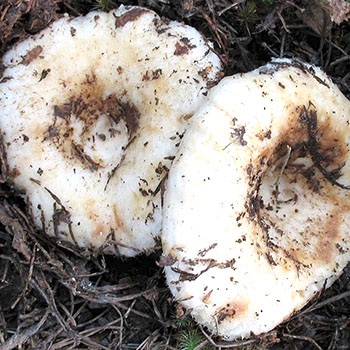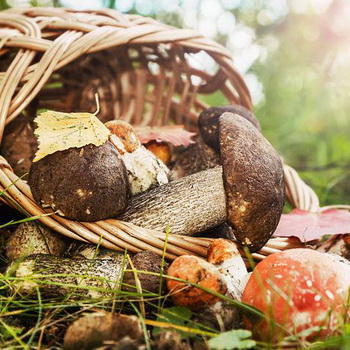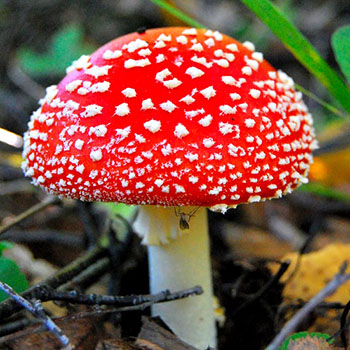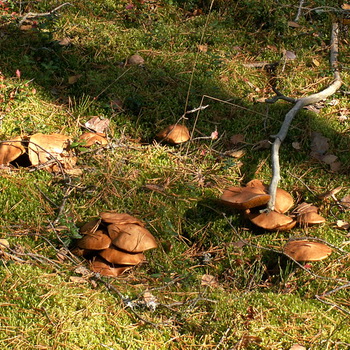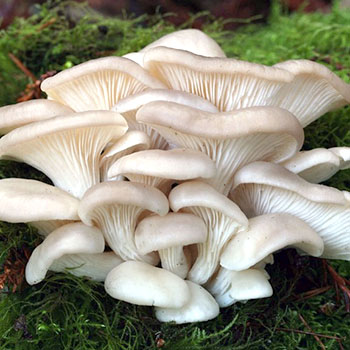July mushrooms
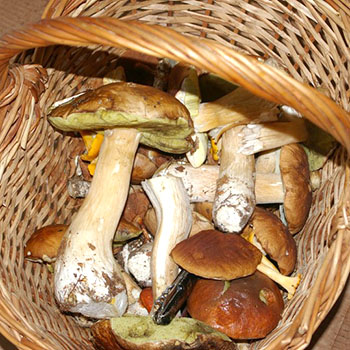
Midsummer is a time of fragrance and flourishing of all nature. Although the month of July is not the peak of “silent hunting,” it is in this month that you can make the first test trips into the forest.
What mushrooms grow in July and how they look is described in detail on this page.
Content
Mushrooms from the Borovik clan
Mushroom, or appendage (Boletus appendiculatus).
Habitats: these mushrooms grow in the forest in July alone and in groups in mixed plantings with beech, oak, hornbeam, and also among firs.
Season: from June to September.
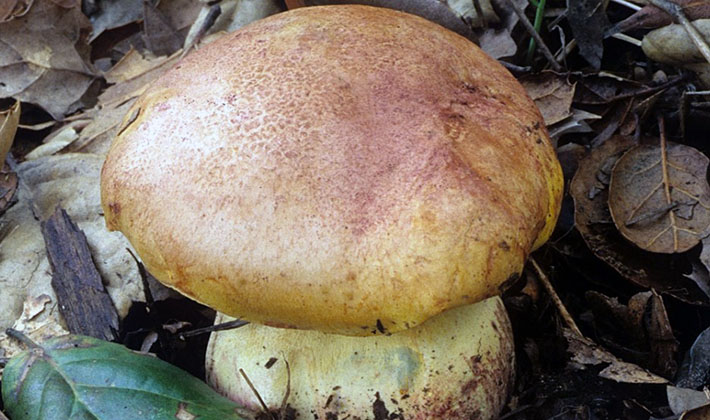
The cap is 5-20 cm in diameter, in young mushrooms it is convex, cushion-shaped, then convex. A distinctive feature of the species is a leathery, initially velvety, later even hat of yellow-brown, brown-brown color. The peel is not removable. The hat is dull in dry weather, and in wet mucous.

Leg 5-15 cm tall, 1-3 cm thick, lemon yellow, mesh, bottom is brownish. The base of the leg often has a conical narrowing.
The pulp is yellow, fleshy, dense, with a pleasant taste, odorless, it turns blue at the cut, with a pleasant taste and smell.
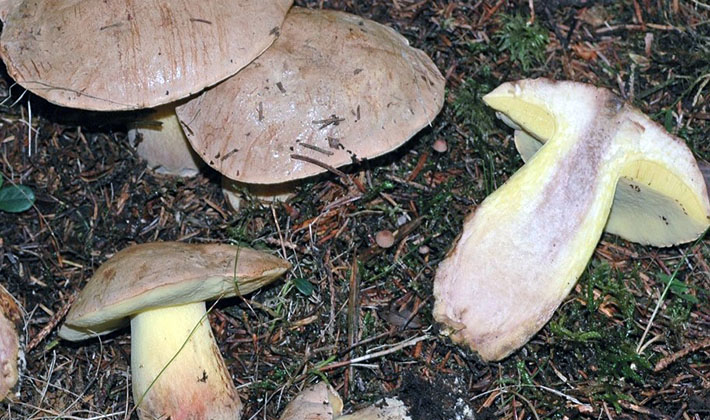
The hymenophore is free, notched, consists of tubules 1-2.5 cm long, which are first lemon yellow, golden yellow, and later yellow brown. When pressed, the tubes acquire a blue-green color. Honey colored spore powder.
Variability: the color of the hat varies from golden brown to tan.
There are no poisonous doubles. Edible porcini mushroom or royal boletus (Boletus regius) is similar in shape to the shape of the hat and the color of the legs, which is distinguished by a thicker leg and the color of the hat with shades of red.
Cooking Methods. Mushrooms are dried, pickled, canned, soups are prepared.
Edible, 1st category.
Pasture boletus (Boletus pascuus).
Habitats: in glades, pastures rich in organic matter, near mixed forests.
Season: from June to September.
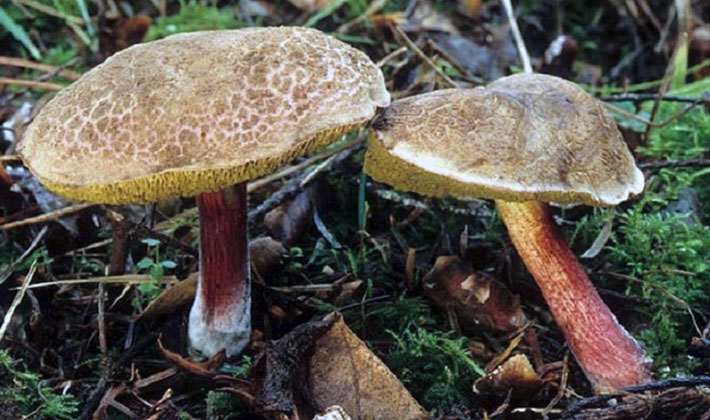
The hat is 3-10 cm in diameter, at first - hemispherical, later cushion-shaped and convex. A distinctive feature of the species is a fissured and spotted yellow-red, burgundy red, tan hat, first velvety, later smooth. The peel is not removable.
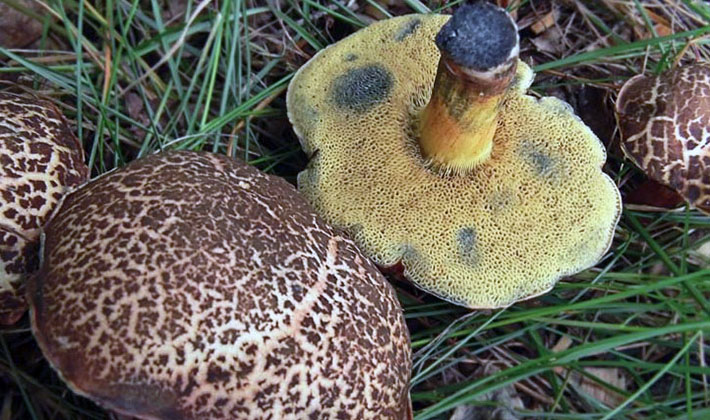
Leg 3-8 cm tall, 7-20 mm thick, cylindrical. The color of the legs above is yellow, below is reddish.
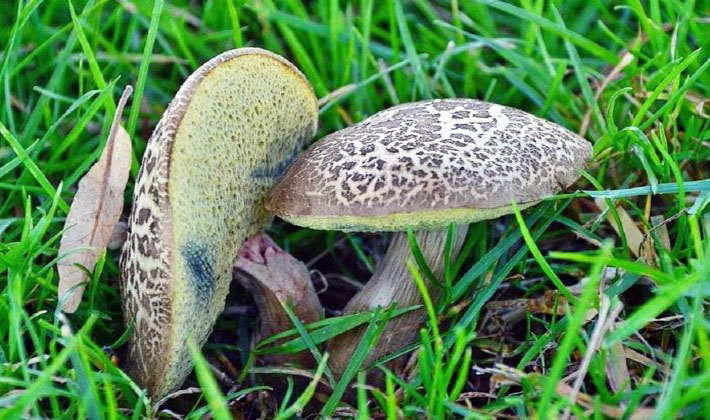
The pulp is dense, at first whitish, later light yellow, it turns blue at the cut, the taste and smell are pleasant.
The tubular layer is free, first yellow, later greenish-yellow, when pressed, it acquires a bluish tint. The spores are olive brown.
Variability: the color of the hat changes from red-brown to brown-brown.
Similar views. The pasture boletus is similar to the mottled boletus (Boletus chrysenteron), which differs in the uniform coloring of the hat.
Cooking Methods: pickling, salting, frying, cooking soups, drying.
Edible, 2nd category.
Cep is a mushroom from the Borovik clan. Russian mushroom pickers have a special attitude to porcini mushrooms. Meeting with them is fascinating and uplifting. There is a desire to photograph them and look for more and more. Recently, more and more often they photograph the found whites on a cell phone. These wonderful mushrooms are not only beautiful, but healthy and healing.
Porcini mushroom, spruce (Boletus edulis, f. Edulis).
Habitats: singly and in groups in coniferous and mixed with spruce forests.
Season: from the beginning of July to half of October.
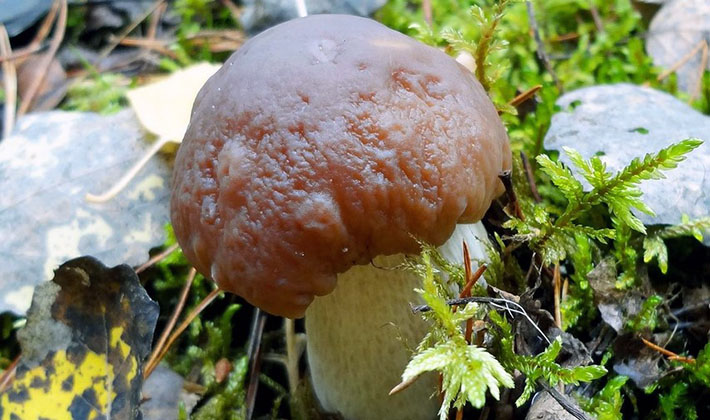
The cap is 4-16 cm in diameter, in young mushrooms it is convex, cushion-shaped, then flatter, smooth or slightly wrinkled. In wet weather, the hat is mucous, in dry - shiny. A distinctive feature of the species is the color of the hat - reddish-brown or chestnut-brown, as well as the presence of places with lighter and darker areas. The edge of the cap is even, slightly tucked in young mushrooms. The hat is fleshy and dense.
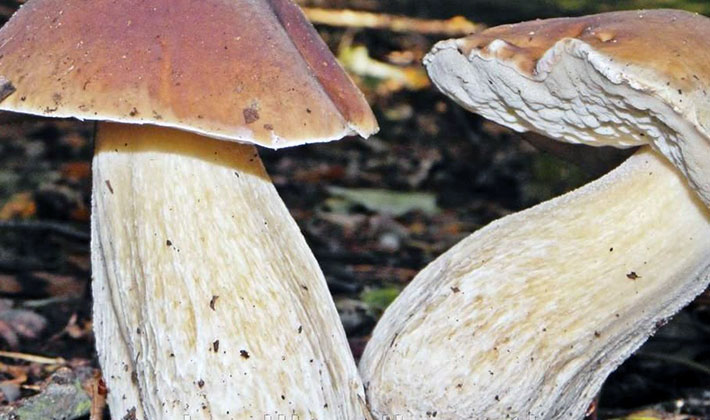
The leg is long, light with a pale mesh pattern, 6–20 cm high, 2–5 cm thick, in the lower part expanded or club-shaped, in the upper part colored more intensely, white below.
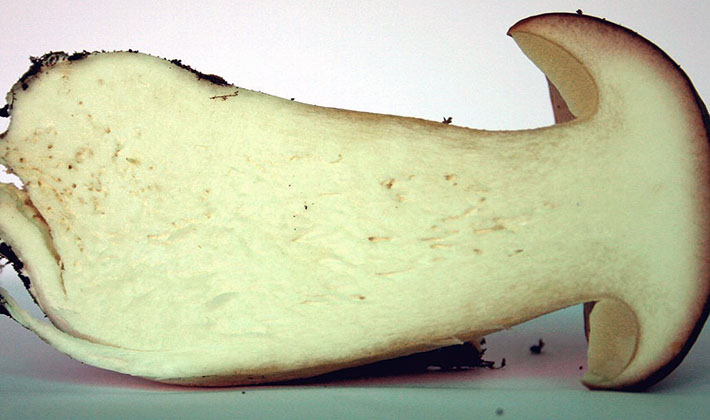
Pulp. The second distinctive feature of the species is a very dense pulp, white, which does not change color at the break. There is no taste, but it has a pleasant mushroom smell.
The hymenophore is free, notched, consists of tubules 1-2.5 cm long, white, then yellow, with small rounded tubular pores.
Variability: the color of the hat varies from chestnut brown to light chestnut and bright brown; the leg in the upper part can have a color from light brown to reddish.
There are no poisonous doubles. Inedible bile mushrooms (Tylopilus felleus), in which the flesh has a pinkish tinge and a burning bitter taste, are similar in size and color to the hats.
Edible, 1st category.
White mushroom (common) (Boletus edulis).
Habitats: singly and in groups in mixed and coniferous forests, forest parks.
Season: from June to half of October.
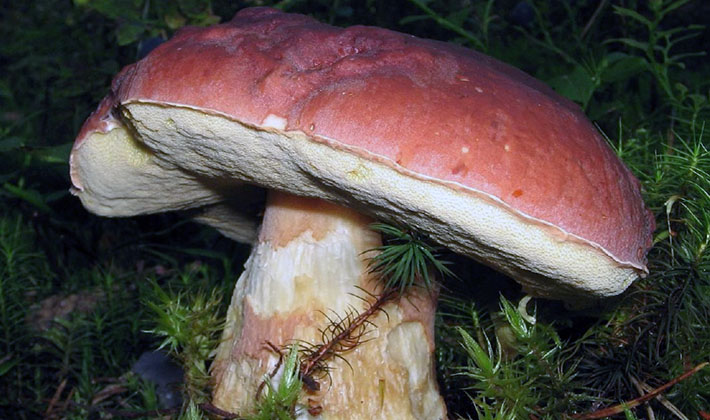
The hat is 5–25 cm in diameter, in young mushrooms it is hemispherical, then convex and then flatter, smooth with folded edges. The skin is velvety-wrinkled, shiny and slightly sticky in wet weather. The color of the hat is dark brown, light brown, brick red. The peel is not removable. The edge of the cap is even, slightly tucked in young mushrooms. The hat is fleshy and dense.
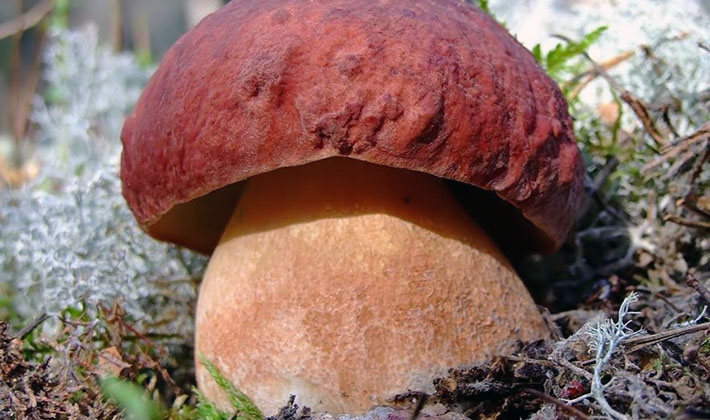
The leg is massive, dense, cylindrical, sometimes thickened from below or even tuberous, medium and large length, light with a dull light brown mesh pattern in the upper part, and in the lower part smooth and lighter. The height of the mushroom is 6-20 cm, the thickness is 2-5 cm.
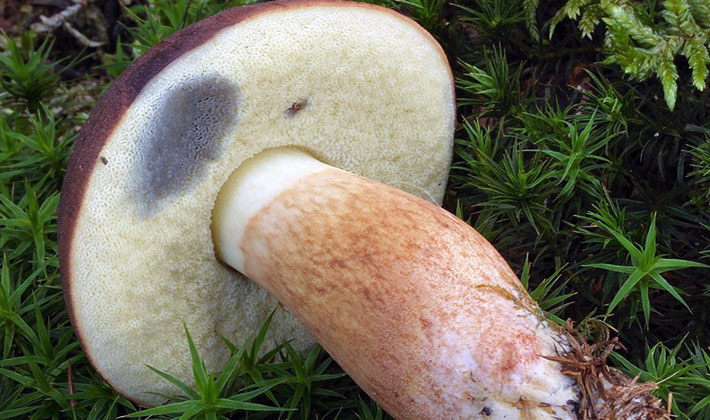
The pulp is dense, white in young specimens and spongy. Further, it changes color to yellowish-greenish. She has no taste, but has a pleasant mushroom smell.
Tubules are narrow and long, not attached to the stem and easily detachable from the cap.
Variability: the color of the hat varies from whitish to dark brown and even grayish. The leg at the top can be light yellow to light brown in color.
There are no poisonous doubles. Inedible bile mushrooms (Tylopilus felleus), in which the flesh has a pinkish tinge, an unpleasant odor and a very bitter taste, are similar.
Methods of preparation: drying, pickling, canning, cooking soups.
Edible, 1st category.
Boletus edulis, reticular form (Boletus edulis, f. Reticulates).
Habitats: singly and in groups in oak and hornbeam forests.
Season: from June to mid-October.
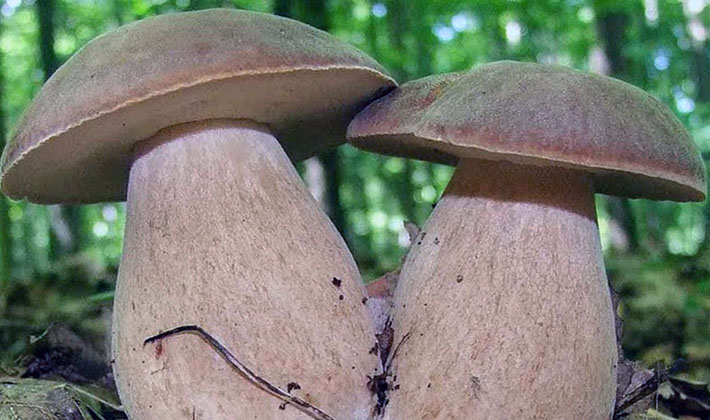
The cap is 4-15 cm in diameter, in young mushrooms it is convex, pillow-shaped, then flatter, smooth or slightly wrinkled. In wet weather, the hat is mucous, in dry - shiny. The color of the hat is brick red, dark brown, brown or light brown. The peel is not removable. The edge of the cap is even, slightly tucked in young mushrooms. The hat is fleshy and dense.
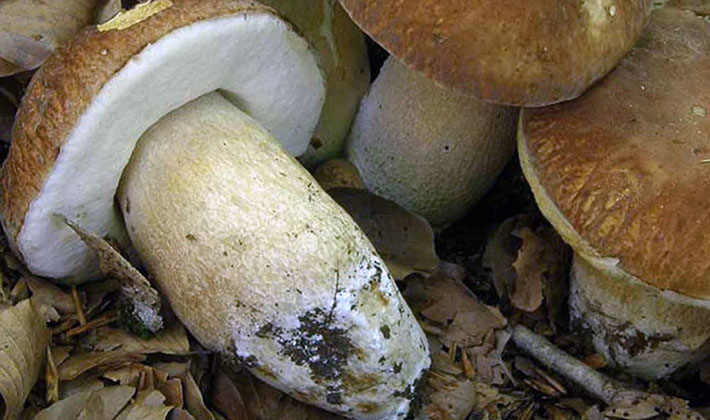
Leg. A distinctive feature of the species is a pronounced mesh on the leg. A light cream mesh is superimposed on a red or brown background.The leg is of medium length, 5–13 cm high, 1.5–4 cm thick, in the lower part expanded or club-shaped, in the upper part colored more intensely.
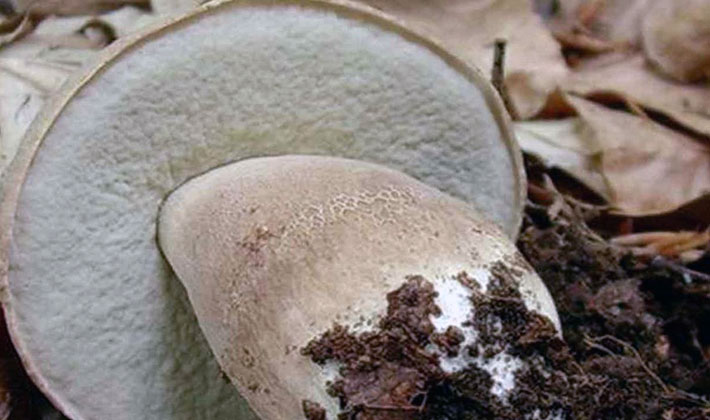
The pulp is dense, white, has no color at the fracture. The taste does not, but it has a pleasant mushroom smell.
The hymenophore is free, notched, consists of tubules 1-2.5 cm long, white, then yellow, with small rounded tubular pores.
Variability: the color of the hat varies from dark brown and dark brown to light brown, similarly the color of the legs.
There are no poisonous doubles. Inedible bile mushrooms (Tylopilus felleus), in which the flesh has a pinkish tinge and a bitter taste, are similar in size and color to the hats.
Edible, 1st category.
Copper porcini mushroom (Boletus aereus).
Habitats: in deciduous and mixed forests.
Season: from the beginning of July to October.
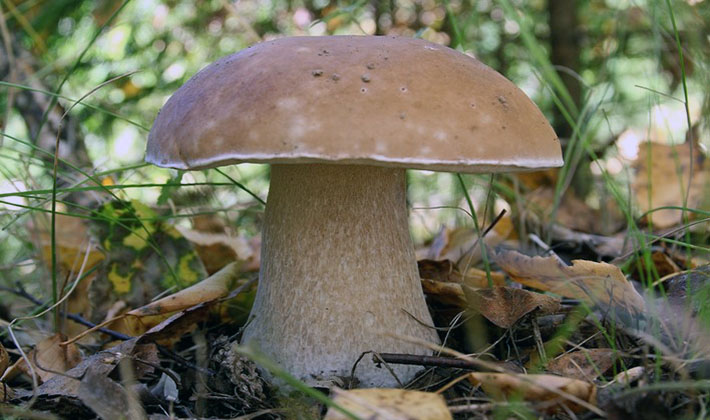
The cap is 4-10 cm in diameter, in young mushrooms it is convex, pillow-shaped, then flatter, smooth or slightly wrinkled. In wet weather, the hat is mucous, in dry - shiny. A distinctive feature from other porcini mushrooms is the color of the hat - brownish or dark brown. The edge of the cap is even, slightly tucked in young mushrooms. The hat is fleshy and dense.
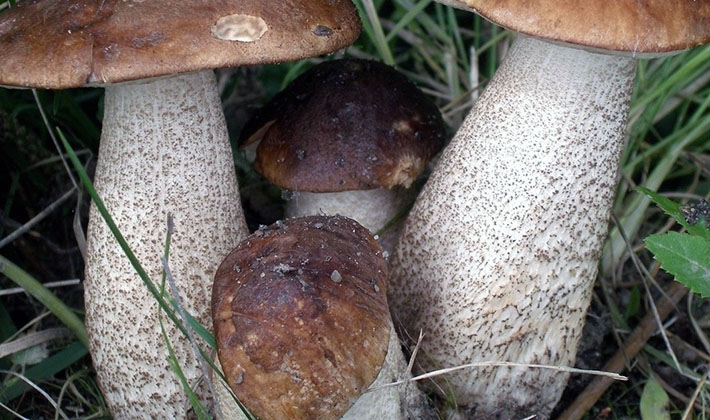
The leg is long, light with a dull mesh pattern, 6–20 cm high, 2.5–4 cm thick, in the lower part expanded or club-shaped. The leg is covered with light brown stains.
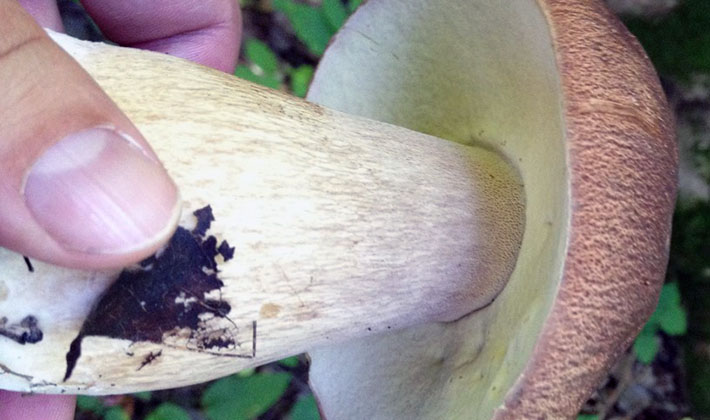
The pulp is dense, in young mushrooms it is white or light yellow, in mature ones it is yellowish. When pressed, the color does not change. The taste does not, but it has a pleasant mushroom smell.
The hymenophore is free, notched, consists of tubules 1-2.5 cm long, white, then yellow, with small rounded tubular pores.
Variability: the color of the hat varies from light brown to dark and bright brown, the leg in the upper part can have a color from light brown to reddish.
There are no poisonous doubles. Inedible bile mushrooms (Tylopilus felleus), in which the flesh has a pinkish tinge and a bitter taste, are similar in size and color to the hats.
Edible, 1st category.
The healing properties of ceps
- They contain more than in other mushrooms, vitamin A (in the form of carotene), B1, C, and especially D.
- Ceps contain the most complete set of amino acids - 22.
- Used to treat ulcers, boils with an aqueous solution.
- It is used for frostbite: mushrooms are dried (dried), an extract is made and frostbite parts of the body are treated.
- Dried porcini mushrooms retain all the best healing properties and are a reliable prevention against the occurrence of cancer.
- Improve metabolism.
- They have a general strengthening effect on the body when taking mushroom powder, 1 teaspoon per day.
- Reduce blood pressure.
- In ceps, a herzedine alkaloid was found, which is taken for angina pectoris, while immunity increases, heart pains decrease.
- Antibiotics have been found in porcini mushrooms that kill E. coli and Koch sticks, causing diarrhea. They make tincture from them to eliminate intestinal infection.
- As an aid, they are used to treat tuberculosis.
- Systematic use helps eliminate gastrointestinal diseases.
- They contain an increased concentration of riboflavin - a substance responsible for the health and growth of nails, hair, skin and overall health. Riboflavin is especially important for maintaining normal thyroid function.
- The drug is a breakdown.
- It has long been believed that taking porcini mushrooms reduces headaches and heals the heart.
Boletus
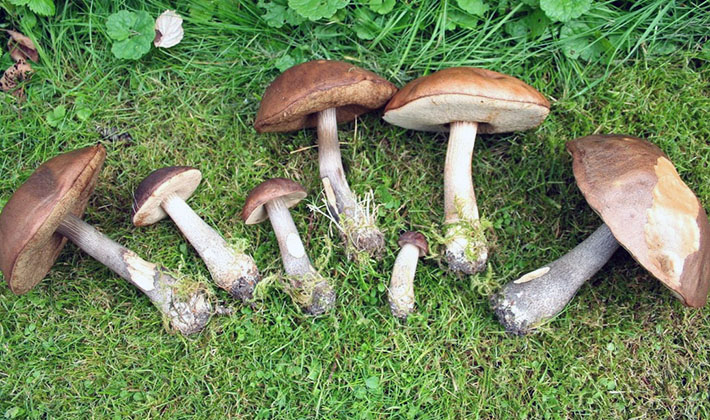
The number of brown boletus grows sharply in July. Now they appear everywhere: in marshy places, next to paths, in clearings, under trees. Preference is given to mixed forests with birch and spruce.
Marsh birch (birch) swamp (Leccinum holopus).
Habitats: individually and in groups in sphagnum bogs and in moist mixed forests with birch trees, near water bodies.
Season: from July to the end of September.
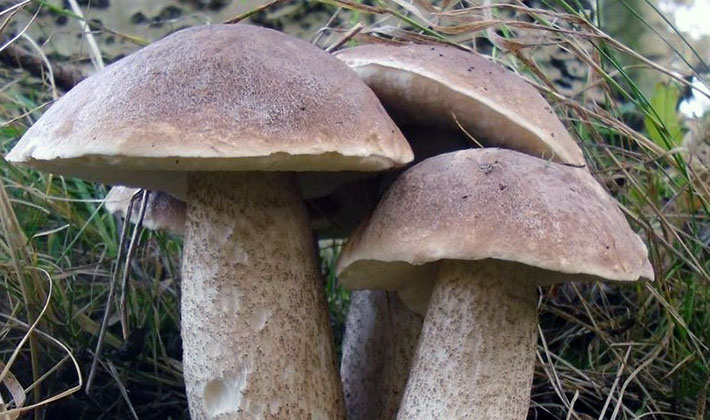
The cap is 3-10 cm in diameter, and in some cases up to 16 cm, in young mushrooms it is convex, cushion-shaped, then flatter, smooth or slightly wrinkled. A distinctive feature of the species is the color of the hat - whitish-cream, grayish-bluish, grayish-greenish.
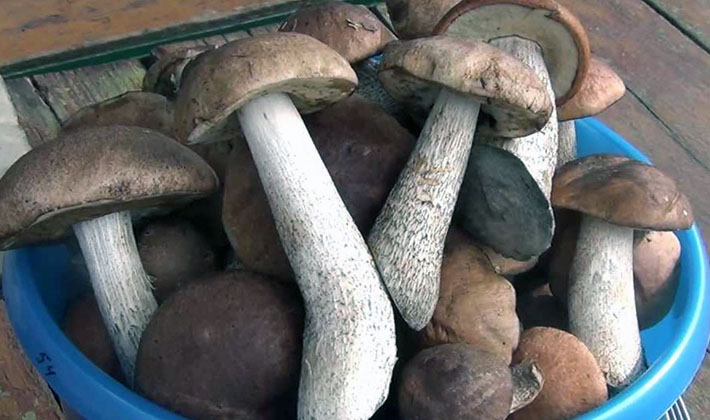
The leg is thin and long, whitish or grayish, with whitish scales that become brownish when dried. Height 5-15 cm, thickness 1-3 cm.
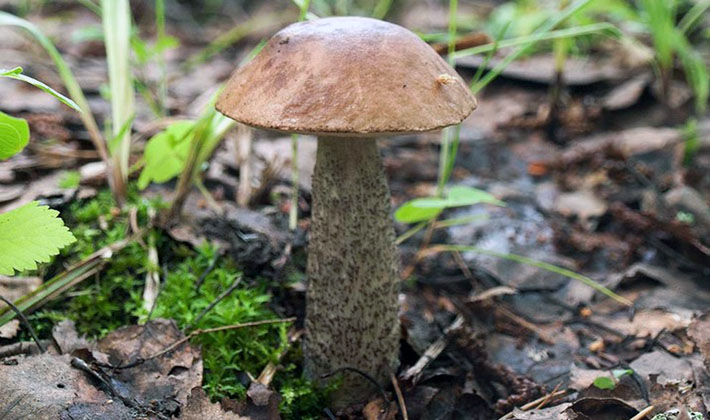
The pulp is soft, white, slightly greenish, watery, at the base of the peduncle bluish-greenish. The pulp does not change color when cut.
The tubular layer is 1.5-3 cm thick, white in young specimens and dirty grayish later, with rounded-angular pore ducts.
Variability: the color of the hat varies from white and light cream to bluish-green. Tubules and pores - from white to brown. The white leg darkens with age, becoming covered with brownish scales.
There are no poisonous doubles. Inedible bile mushrooms (Tylopilus felleus) are similar in size and shape to hats, in which the flesh has a pinkish tinge and a burning bitter taste.
Edible, 2nd category.
Marsh birch bark, oxidizing form (Leccinum oxydabile).
Habitats: individually and in groups in sphagnum bogs and in moist mixed forests with birch trees, near water bodies.
Season: from July to the end of September.
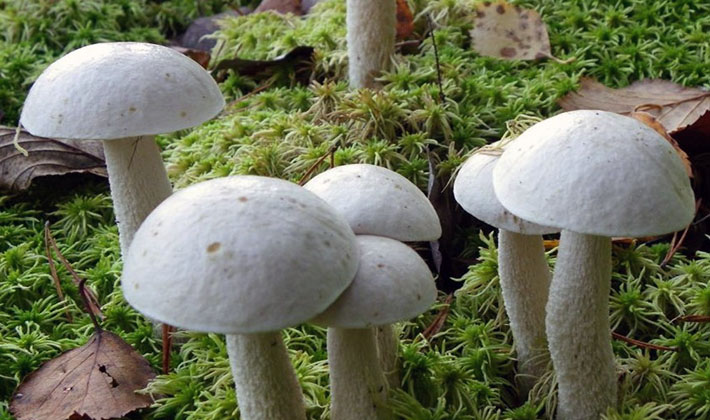
The hat is 3-8 cm in diameter, and in some cases up to 10 cm, in young mushrooms it is convex, cushion-shaped, then flatter, smooth or slightly wrinkled. A distinctive feature of the species is the color of the hat - whitish-cream with yellowish spots.
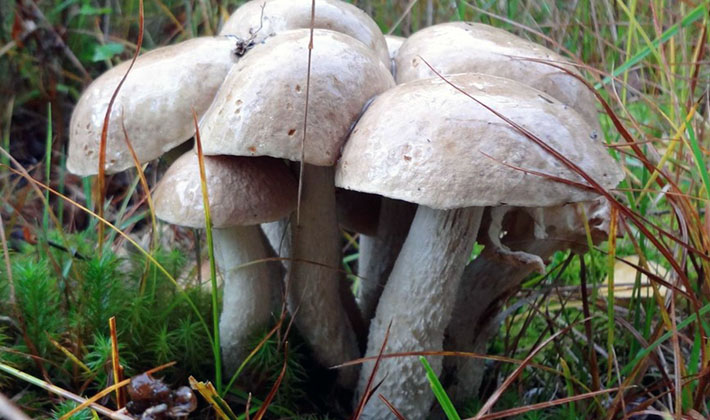
The leg is thin and long, whitish or whitish-cream, covered with gray-cream scales, which upon drying become gray-brownish. Height is 5-15 cm, sometimes reaches 18 cm, thickness is 1-2.5 cm. The second distinctive feature of the species is the ability to oxidize quickly, which is expressed by the appearance of pinkish spots when touched.
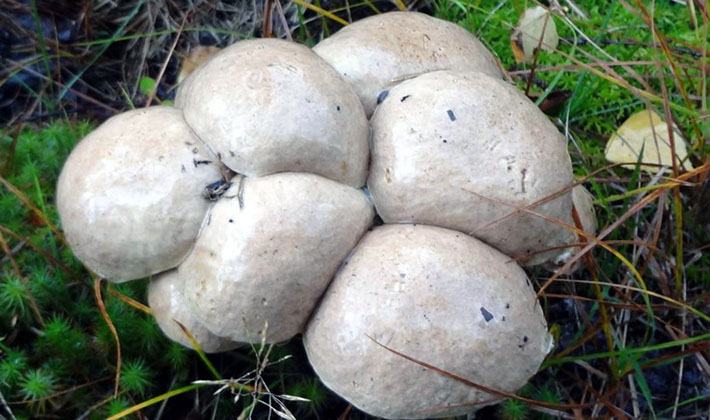
The pulp is soft, white, dense, has a light mushroom aroma, quickly turns pink at the break. The hymenophore is whitish, with time it becomes grayish.
The tubular layer 1.2–2.5 cm thick is white in young specimens and is dirty grayish later, with roundish-angled pores of the tubules.
Variability: the color of the hat varies from white and light cream to pinkish-cream. Tubules and pores - from white to gray. The white leg darkens with age, becoming covered with brownish-gray scales.
There are no poisonous doubles, but from far away in the color of the hat this boletus can be confused with the deadly poisonous white form of a pale toadstool (Amanita phalloides), which upon closer examination differs sharply by the presence of a ring on the leg and a volva at the base.
Edible, 2nd category.
Boletus, the form of a hornbeam (Leccinum carpini).
Habitats: singly and in groups in deciduous forests.
Season: from July to the end of September.
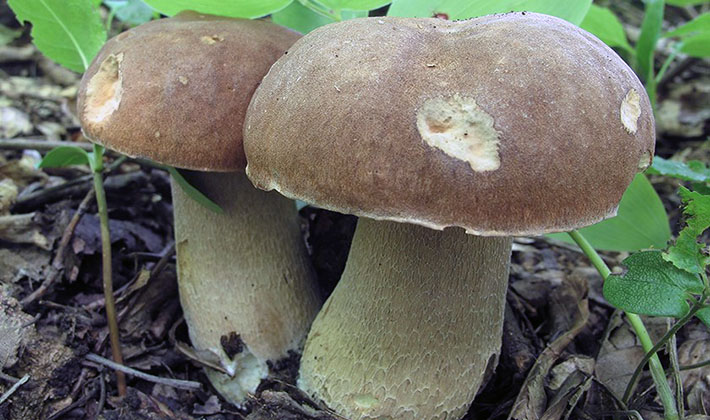
The hat is fleshy 3-8 cm in diameter, and in some cases up to 12 cm. The shape of the hat is hemispherical, with age it becomes less convex. A distinctive feature of the species is the granular surface of the cap and gray-brown color. In young specimens, the edge of the cap is bent; in mature specimens, it straightens.
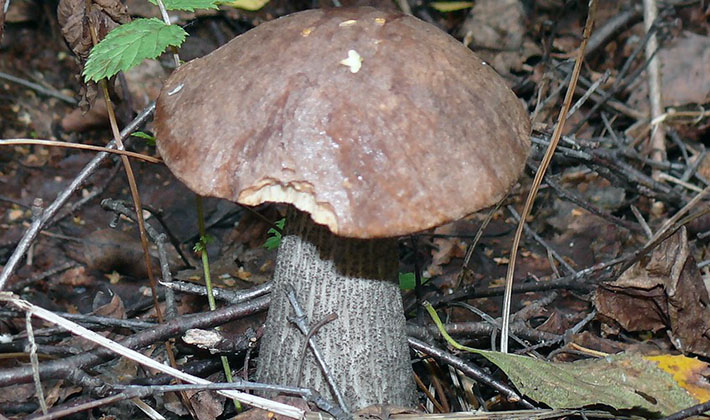
The leg is thin and long, light brown, cylindrical, covered with blackish scales, narrowed in the upper part.
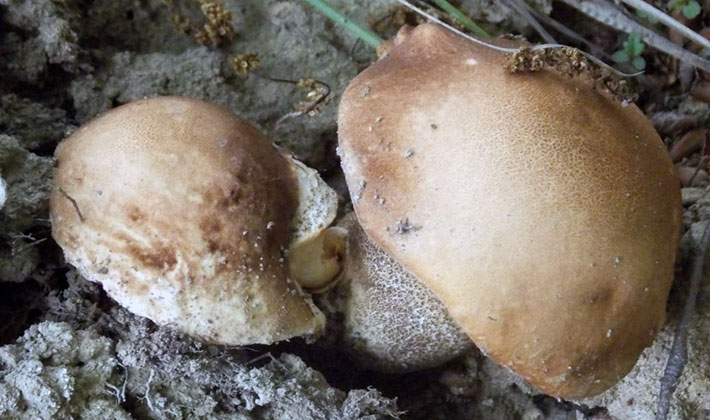
The pulp at the break is colored first in pinkish-purple, then in gray and later in blackish color.
Tubular layer up to 2.5 cm thick with very fine white pores.
Variability: the color of the hat varies from gray-brown to ash gray, buffy and even whitish. As the mushroom ripens, the cap's skin can shrink, exposing the surrounding ducts. Pores and tubes are whitish at first, then gray. The scales on the leg are first whitish, then light yellow and finally blackish brown.
There are no poisonous doubles. A little similar bile mushrooms (Tylopilus felleus), in which the flesh with a pinkish tinge, have an unpleasant odor and a very bitter taste.
Methods of preparation: drying, pickling, canning, frying.It is recommended to remove the leg before use, and in older mushrooms - the skin.
Edible, 2nd category.
Brown boletus (Leccinum brunneum).
Habitats: birch, coniferous and mixed forests.
Season: from June to October.
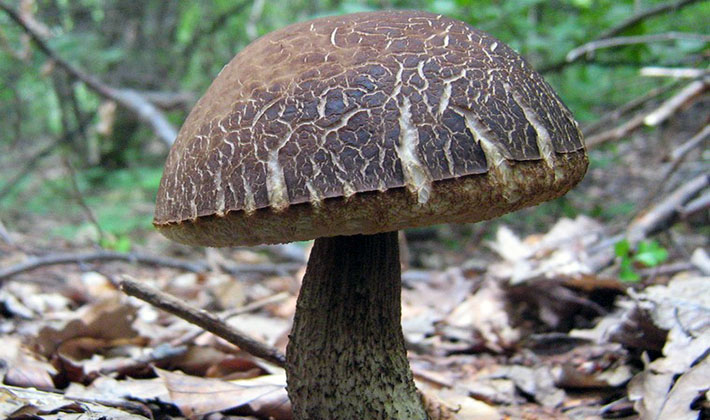
The hat is fleshy 5-14 cm in diameter, and in some cases up to 16 cm. The shape of the hat is hemispherical with a slightly woolly surface, with age it becomes less convex. A distinctive feature of the species is a brown hat with a reddish tint with a shiny surface. The lower surface is finely porous, the pores are creamy gray, yellowish gray.
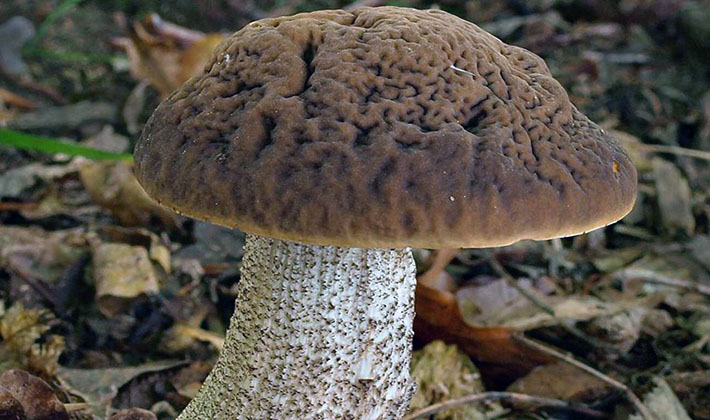
Leg of gray-cream color, covered with black scales along the entire length, in mature specimens - dark.

The pulp is dense whitish, in the section it is painted in gray-black color.
Tubular layer up to 2.5 cm thick with very fine white pores.
Variability: the color of the hat varies from brown to brownish brown. As the mushroom ripens, the skin of the cap can become sticky and shiny to drier and dull. The pores and tubes are whitish at first, then yellow-gray. The scales on the leg are gray at first, then almost black.
There are no poisonous doubles. The bile mushrooms (Tylopilus felleus), which have a pinkish tint and have an unpleasant odor and a very bitter taste, are slightly similar to these boletus birch mushrooms.
Methods of preparation: drying, pickling, canning, frying. It is recommended to remove the leg before use, and in older mushrooms - the skin.
Edible, 2nd category.
Boletus
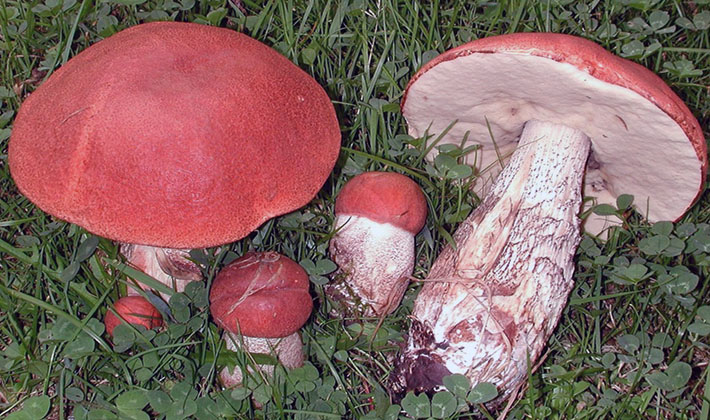
Boletus and boletus by name in Latin do not differ (Leccinum). This is not accidental, since the properties of these mushrooms are close. To the taste, fried boletus is a bit sweeter. In addition, cooked boletus almost always darkens, and boletus blackens much less. Our nature lovers value aspen boletus because of their beauty and taste.
Therapeutic properties:
- A complete set of amino acids.
- Many salts of iron, phosphorus and potassium.
- Rich in vitamins A, B, B1, PP.
- Boletuses perfectly clean blood and lower cholesterol. If you take 1 teaspoon of boletus powder daily for a month, then the blood improves.
Orange-yellow boletus (Leccinum testaceoscabrum)
Habitats: deciduous, mixed and pine forests grow individually and in groups.
Season: June - early October.
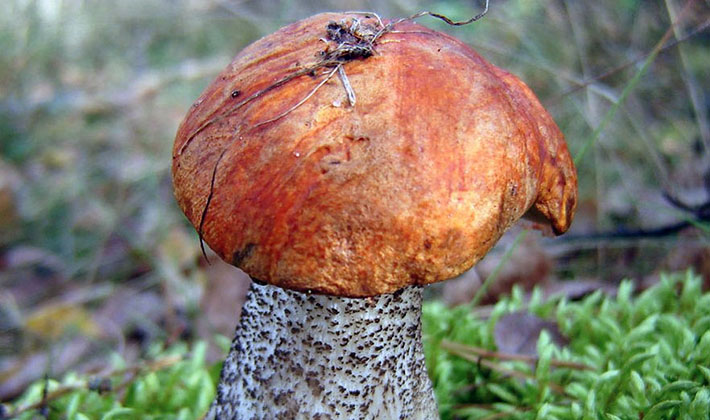
The hat is tight 4-12 cm in diameter. The shape of the cap is hemispherical, then less convex, prostrate. A distinctive feature of the species is the orange-yellow color of the hat with reddish stains. The surface is velvety or smooth, dry, and slightly humid in wet weather. The lower surface is finely porous, the pores are light gray or ocher-gray.
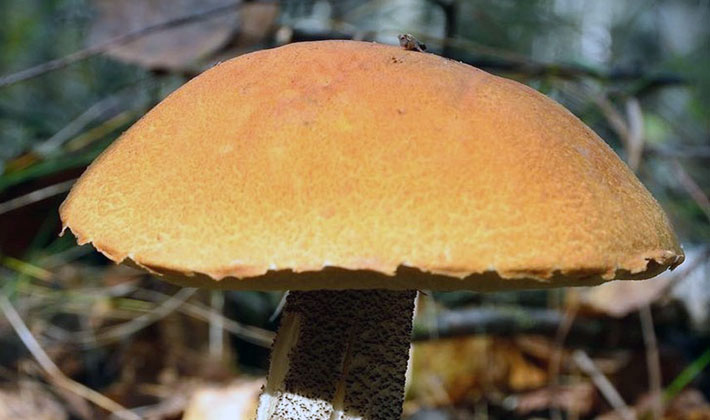
Leg 5-16 cm long. The second distinctive feature of the species is a long cylindrical leg of white color with white flaky scales without expansion near the base. In mature mushrooms, the scales darken slightly, the thickness of the legs is 1-2 cm.
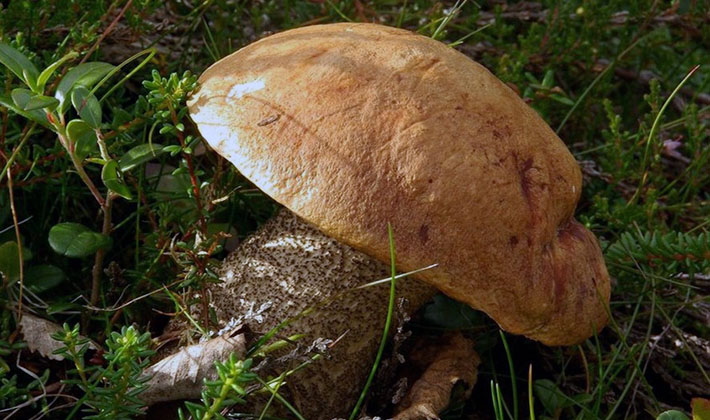
The flesh is thick, dense, white; on the fault it acquires a color from lilac to gray-black.
The tubular layer is off-white or grayish with small rounded tubular pores. Spore powder is brown-buff.
Variability: over time, the hat becomes dry and velvety, and the color of the hat changes from yellow-orange to red. As the mushroom ripens, the cap's skin can shrink, exposing the surrounding ducts. The scales on the leg are first white, then gray.
The bottom surface of the hat may have a tint from whitish yellowish to grayish.
There are no poisonous doubles. The orange-yellow cap boletus is similar in color to the edible white mushroom of the orange-red shape (Boletus edulis, f. Auranti - oruber), which is distinguished by a thick club-shaped leg and the presence of a net reddish pattern on the leg.
Methods of preparation: dried, canned, stewed, fried.
Edible, 2nd category.
Boletus white (Leccinum percandidum).
Habitats: the mushroom is listed in the Red Book of the Russian Federation and regional Red Books. Status - 3R (rare species).Mushrooms grow in small glades, where there are many ferns on the border of growth of deciduous and mixed forests.
Season: end of June - end of September.
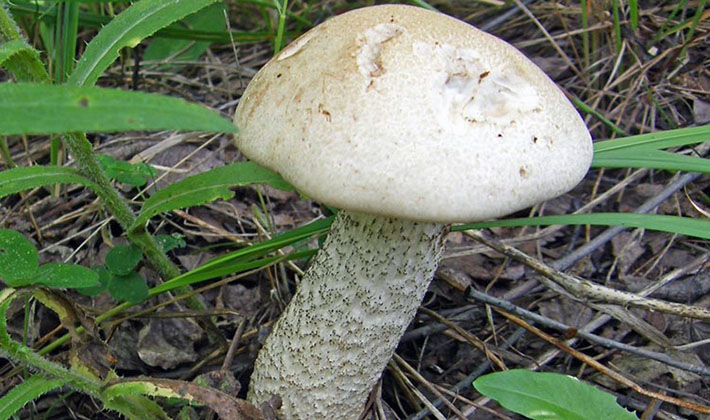
The hat is fleshy 5-12 cm in diameter, and sometimes up to 20 cm. The shape of the hat is hemispherical. A distinctive feature of the species is its internal shape - it, “like a hat”, has an internal volume (concave) compared to other large boletus and boletus, where the underside of the hat is almost flat. The second distinguishing feature is the color of the hat - cream, "ivory", light brown, in old mushrooms the hat becomes yellowish, sometimes brown spots appear. Often, the skin hangs over the edge of the hat.
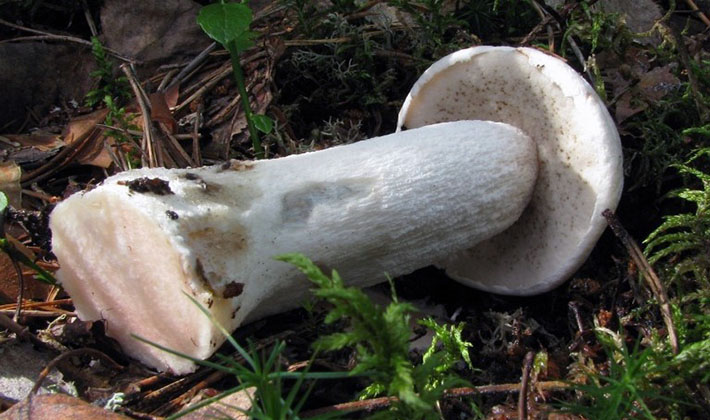
Leg 6-15 cm, thin and long, cylindrical, base slightly thickened. Young mushrooms have a stronger thickening from below. The leg is white with scales, which are almost black in ripe mushrooms, a thickness of 1-2.5 cm.
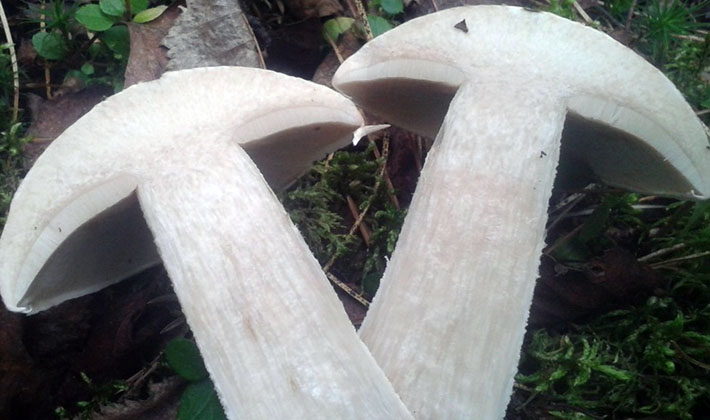
The pulp is dense, white, tinted at the cut, at the base of the leg is yellowish or light cream, and in old mushrooms - with brown spots or just brown. The pulp on the cut of the leg turns blue.
Variability: the color of the hat varies from light cream to yellowish brown. As the mushroom ripens, the cap's skin can shrink, exposing the surrounding ducts. The scales on the leg are gray, then black.
There are no poisonous doubles. The boletus white is similar in color to the hat on the edible bog (Leccinum holopus). The cap boletus differs in the internal shape of the cap - it is concave in comparison with a straight one or, conversely, with a slightly hanging down cap of the cap boletus.
Cooking Methods. Although the mushroom has good taste, but in view of its rarity and inclusion in the Red Book, one should refrain from collecting it and, conversely, contribute in every way to its reproduction. Do not tear these mushrooms, as this can take thousands of spores.
Edible, 2nd category.
Boletus burgundy red (Leccinum quercinum).
Habitats: a rare species that grows alone in deciduous forests mixed with spruce, near swamps.
Season: June - September.
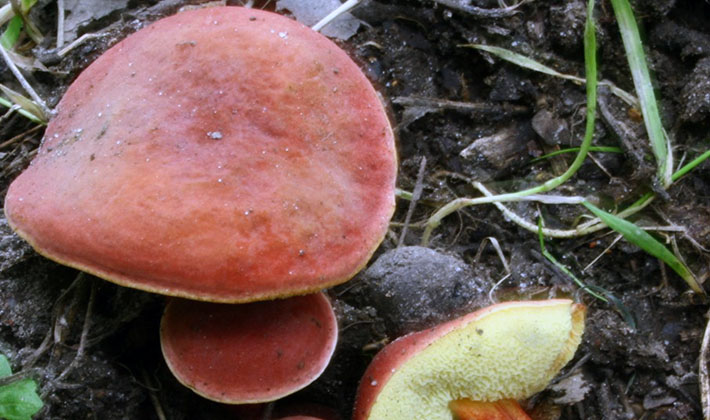
The hat is dense 4-10 cm in diameter, sometimes up to 15 cm. The shape of the hat is hemispherical, similar to a helmet. A distinctive feature of the species is the burgundy-red color of the hat with a finely rough velvety surface. The lower surface is finely porous, the pores are light gray or ocher-gray.
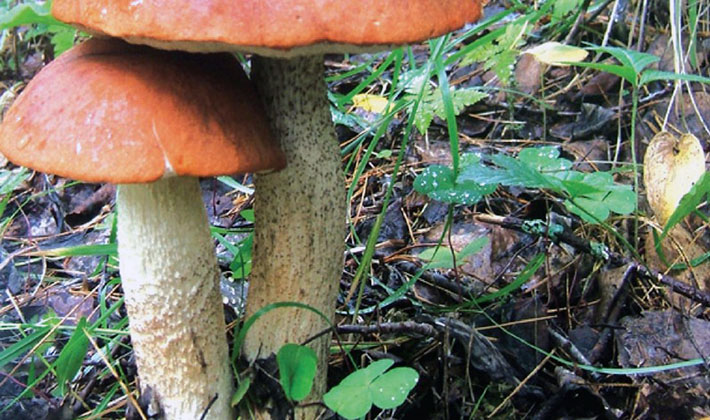
Leg 5-16 cm long. The second distinctive feature of the species is a cylindrical leg of a reddish or reddish-brown color with black spots.

The flesh is thick, dense, white-creamy, on the break it acquires a color from lilac to gray-black.
The tubular layer is white-cream or grayish with small rounded tubular pores. Spore powder is brown-buff.
Variability: the hat becomes dry and velvety over time, and the color of the hat changes from burgundy red to burgundy. As the mushroom ripens, the cap's skin can shrink, exposing the surrounding ducts. The bottom surface of the hat can range from whitish cream to yellowish gray.
There are no poisonous doubles. The boletus burgundy red in color of the hat is similar to the edible white mushroom of the orange-red shape (Boletus edulis, f. Auranti - oruber), which is distinguished by a thick club-shaped leg and the presence of a net reddish pattern on the leg.
Cooking Methods: dried, canned, stewed, fried.
Edible, 2nd category.
Red boletus, or redhead (Leccinum aurantiacum).
Habitats: deciduous, mixed and pine forests grow individually and in groups.
Season: June - end of September.
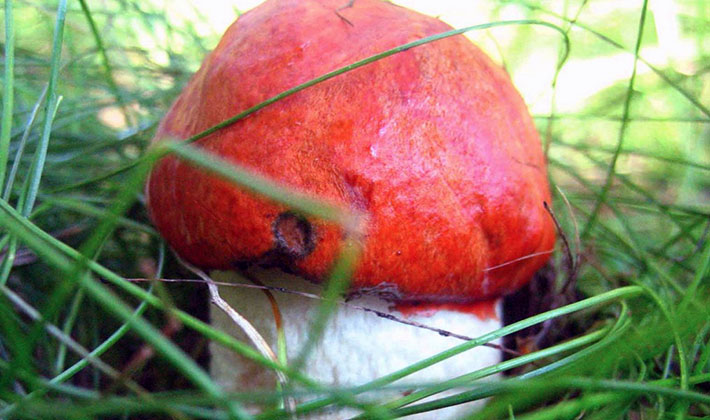
The hat is dense 5-20 cm in diameter, and sometimes up to 25 cm. The shape of the hat is hemispherical, then less convex, outstretched. The color of the hat is orange, rusty red, orange red. The surface is velvety or smooth, dry, and slightly humid in wet weather. The lower surface is finely porous, the pores are light gray or ocher-gray.
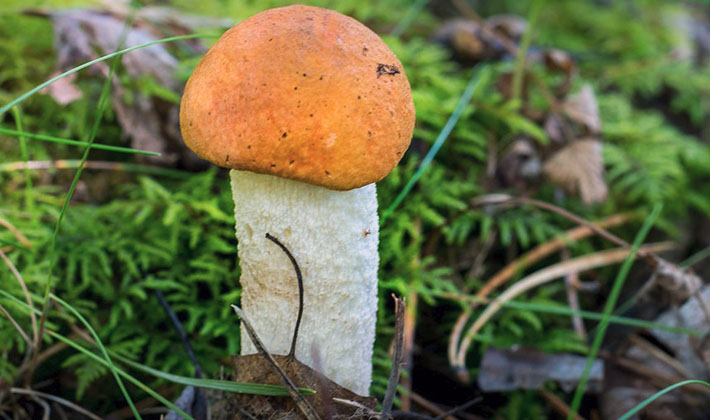
Leg 5-16 cm long, sometimes up to 28 cm, long, cylindrical, sometimes expanding to the base, often curved grayish-white with light flaky scales. In mature mushrooms, the scales darken and acquire an almost black color, the thickness of the stem is 1.5-5 cm.
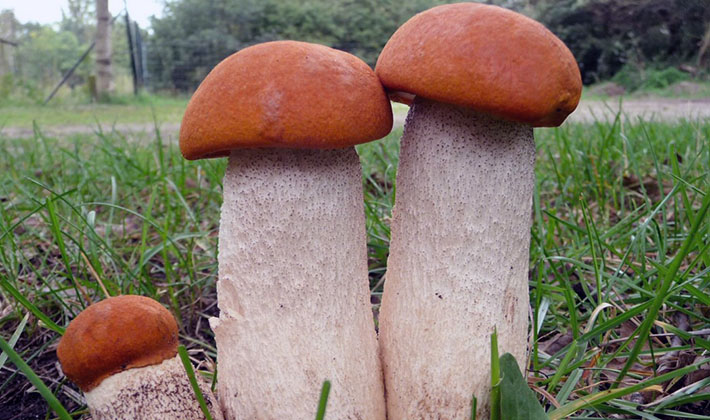
The flesh is thick, dense, white; on the fault it acquires a color from lilac to gray-black, in the lower part of the leg to a faint green-blue color.
The tubular layer is off-white or grayish with small rounded tubular pores. Spore powder - brown-ocher, ocher-brown.
Variability: over time, the hat becomes dry and velvety, and the color of the hat changes from yellow-orange to bright red. As the mushroom ripens, the cap's skin can shrink, exposing the surrounding ducts. The scales on the leg are gray, then black. The bottom surface of the hat may have a tint from whitish yellowish to grayish.
There are no poisonous doubles. The cap boletus red in color is similar to the edible pine-shaped white mushroom (Boletus edulis, f. Pinicola), which is distinguished by a thicker club-shaped leg and the presence of a pattern on the leg with stains or stripes.
Cooking Methods: dried, canned, stewed, fried.
Edible, 2nd category.
Yellow-brown boletus (Leccinum versipelle - testaceoscabrum).
Habitats: birch, pine and mixed forests.
Season: end of June - end of September.
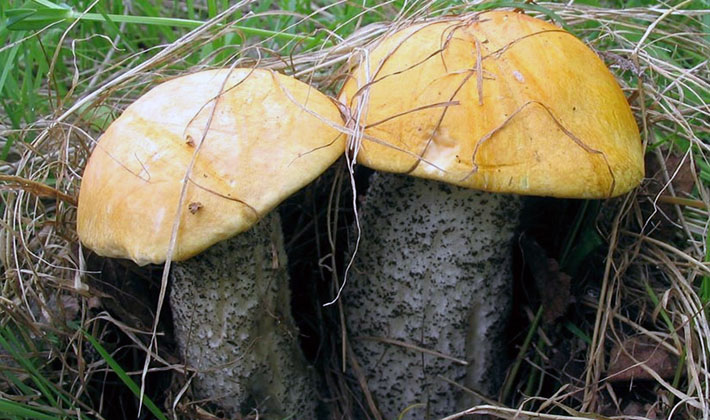
The hat is dense 5-16 cm in diameter, and sometimes up to 20 cm. The shape of the hat is hemispherical, convex. A distinctive feature of the species is the color of the hat - yellow-brown, yellow-orange, bright orange, reddish-brown. The surface is velvety or smooth, dry, and slightly humid in wet weather.
The peel often hangs over the edge of the cap. The lower surface is finely porous, the pores are light gray or ocher-gray.
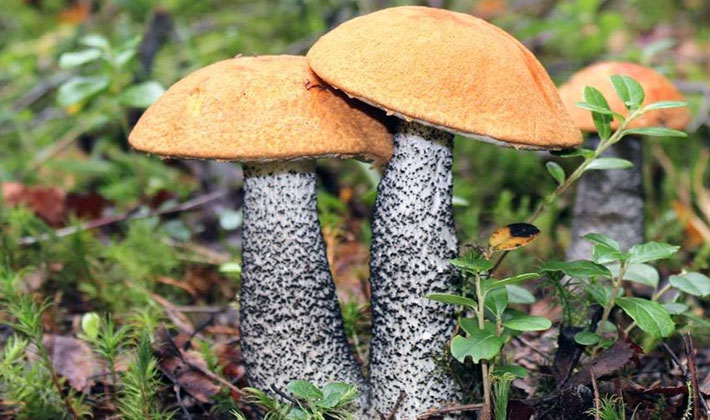
Leg 5-10 cm long, thick and long, club-shaped, tapers up. In young mushrooms, the leg is very thickened. The leg is white with gray scales, which in mature mushrooms are almost black in color, 2-5 cm thick.
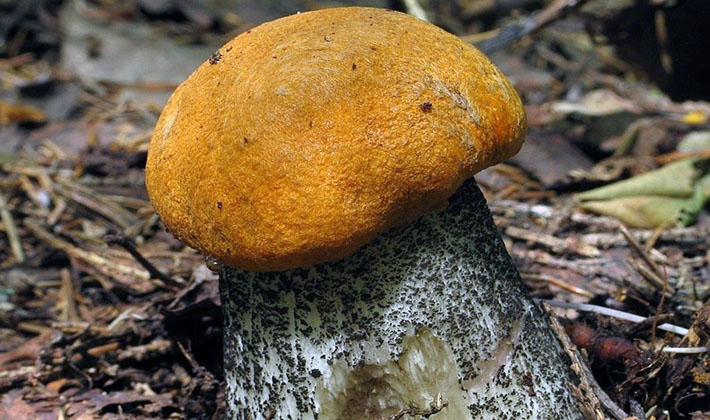
The pulp is dense white, on the fault slightly turns pink, then turns gray and then becomes mauve or dirty gray, and on the leg - blue-green.
Tubules 0.7-3 cm long with small rounded pores. On the section, jagged dirty white tubes are visible. The surface of the tubular layer in young mushrooms is gray, then gray-brown. Spore Powder - Olive Brown
Variability: the color of the hat varies from yellow-brown to bright orange. As the mushroom ripens, the cap's skin can shrink, exposing the surrounding ducts. The scales on the leg are gray, then black.
There are no poisonous doubles. Inedible bile mushrooms (Tylopilus felleus) are slightly similar, in which the flesh with a pinkish tint is very bitter.
Methods of preparation: dried, canned, stewed, fried.
Edible, 2nd category.
Flywheels and goats
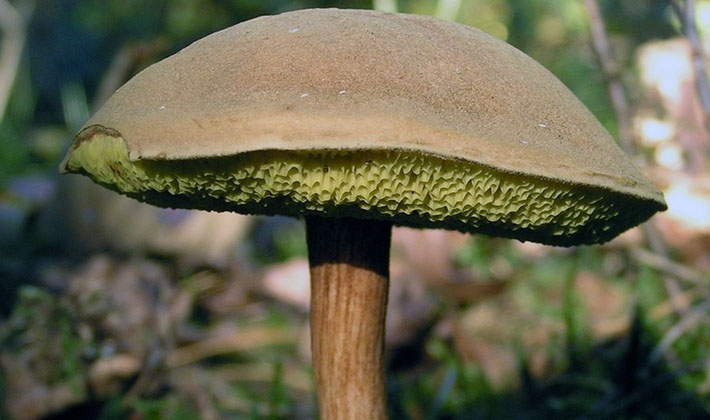
July moss and goats most often grow in mixed forests with oaks and spruces. They are often invisible and hide well in foliage and fallen leaves.
Yellow-brown flywheel (Suillus variegates).
Habitats: grows in pine and mixed forests, singly or in groups. The property of accumulation of harmful substances: this species has the property of strong accumulation of heavy metals, so you should strictly observe the condition for collecting mushrooms in an area no closer than 500 meters from highways and chemical plants.
Season: July - October.

A hat with a diameter of 4-12 cm, pillow-shaped, convex, with bent, and with age with a lowered edge, lemon yellow, yellow-brown or olive-ocher. The peel on the hat is dry, fine-grained or almost felt, with time it becomes smoother, after a rain a little slippery.
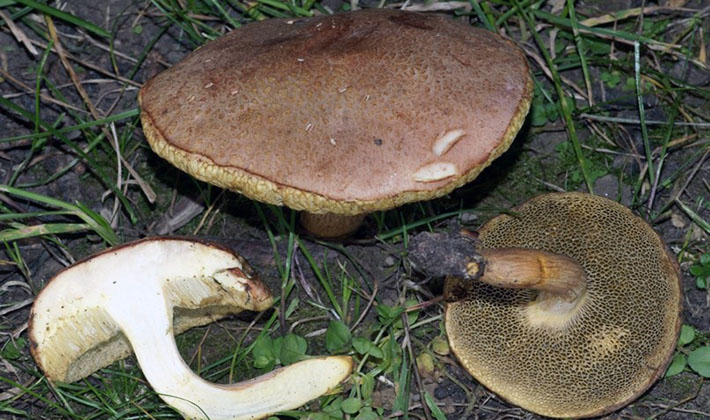
The leg is cylindrical, yellowish, with a dark marble pattern, 5-8 cm high, 1.5-2.5 cm thick.
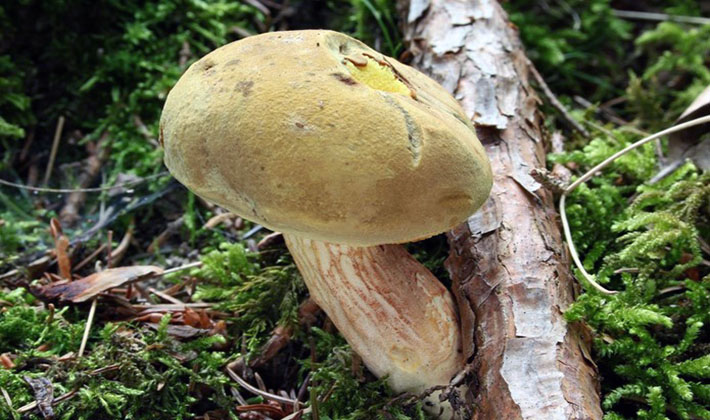
The flesh is yellow, has no smell and taste, slightly blue on the cut.
Tubules in their youth olive shade, then rusty olive.
Variability: over time, the hat becomes dry and velvety, and the color of the hat changes from chestnut to dark brown.The color of the legs varies from light brown and tan to reddish brown.
Similar views. A Polish mushroom (Boletus badius) is similar, but it has not a velvety, but a leathery and oily surface of the hat.
There are no poisonous doubles. A little similar bile mushrooms (Tylopilus felleus), in which the flesh is pinkish, and the hat is brown, they are very bitter.
Cooking Methods: drying, pickling, cooking.
Edible, 3rd category.
Variegated flywheel (Boletus chrysenteron).
Habitats: grows in deciduous and mixed forests, along the edge of roads, ditches, along the edges of the forest. Mushrooms are rare, listed in some regional Red Books, where they have 4R status.
Season: July - October.
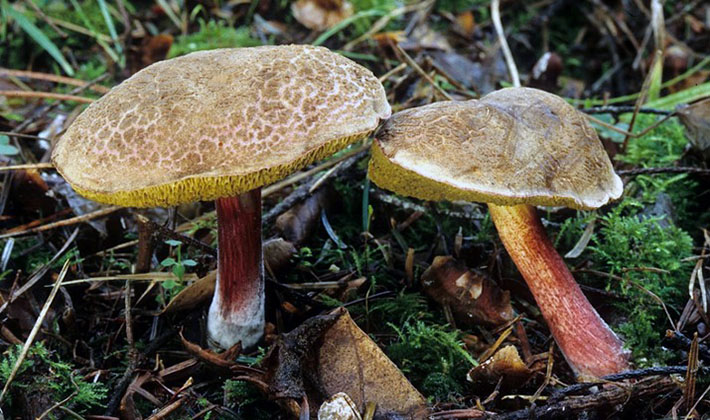
A hat with a diameter of 4-8 cm, sometimes up to 10 cm, hemispherical A distinctive property of the species is a dry, dull, velvety, mesh-cracking, brown-brown, reddish-brown hat. Cracks often have a pink tint.
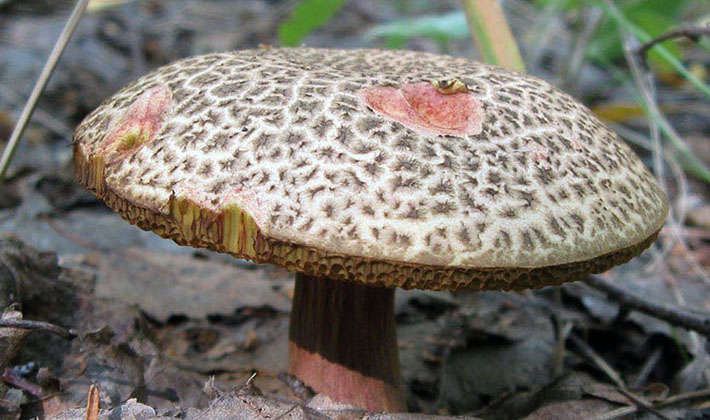
The leg is cylindrical, 3-8 cm high, 0.8-2 cm thick, light yellow, reddish at the bottom. The foot at the base may taper. The leg is often curved, has small reddish scales.
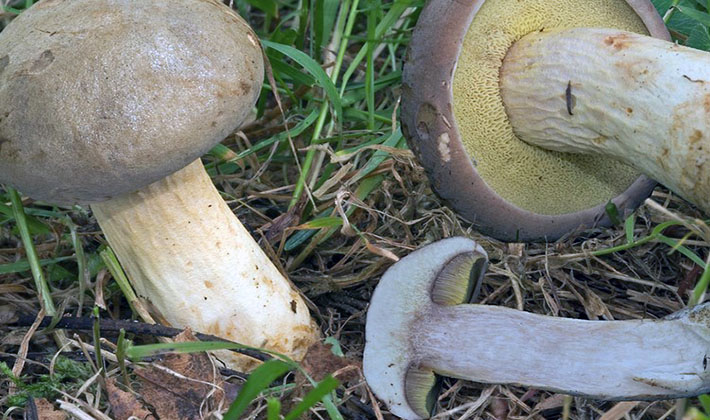
The pulp is dense, whitish or yellowish, under the skin of the hat and at the base the leg is reddish, slightly blue on the break.
Tubules in their youth olive shade, then rusty olive. The spores are olive brown.
The hymenophore has grown, is easily separated from the pulp, consists of tubes 0.4-1.2 cm long, cream-yellow, yellowish-green, later olive in color, turning green at the break. The pores of the tubes are large. Spore powder is yellow-olive-brown.
Variability. The view itself is variable. There are light specimens ocher-gray, almost red and brown, yellowish-cream. There are darker reddish brown and even brown colors. As the mushroom ripens, the cap's skin can shrink, exposing the surrounding ducts.
There are no poisonous doubles. A little similar bile mushrooms (Tylopilus felleus), in which the flesh is pinkish, and the hat is brown, they are very bitter.
Cooking Methods: drying, pickling, cooking.
Edible, 3rd category.
Goat (Suillus bovines).
Habitats: grows in moist pine or mixed forests and in sphagnum bogs.
Season: July - October.
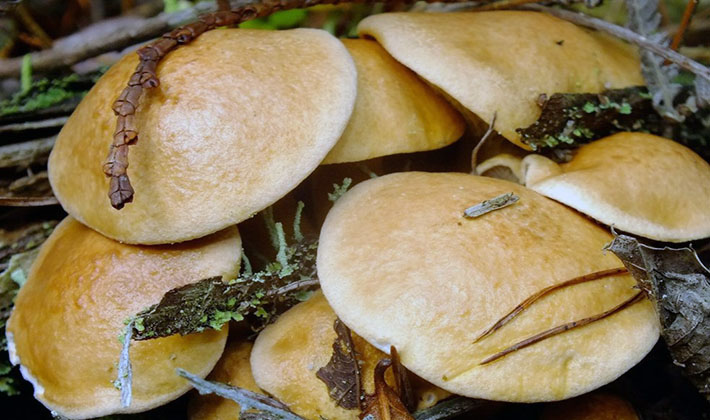
A hat with a diameter of 2-8 cm, but sometimes up to 10 cm, hemispherical, yellow-brown or reddish, dry with a dense yellow down. The film does not separate from the hat. Over time, the shape of the hat flattens. The surface in wet weather is oily.
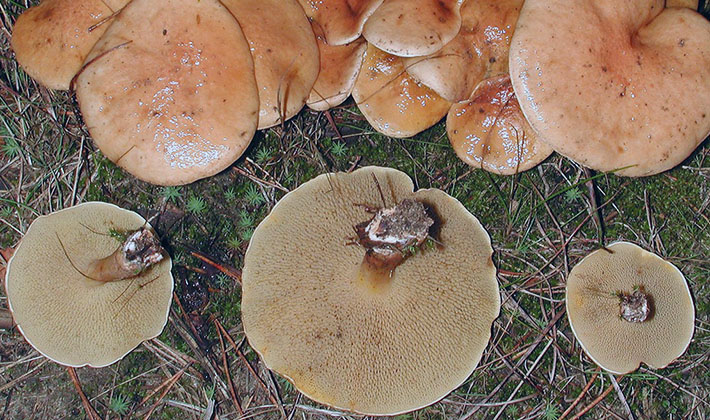
The leg is thin, yellow, 3-8 cm tall, 0.6-2 cm thick, slightly narrowed from below. The color of the legs is more or less uniform, the color is from yellow-brick to reddish.
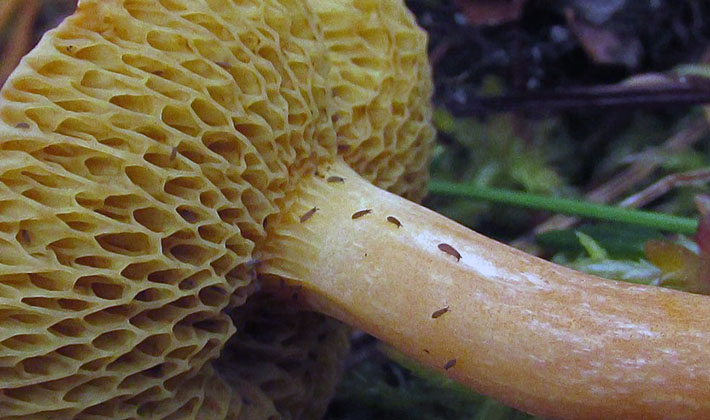
The flesh is soft pinkish, brownish-cream, whitish-yellowish, slightly reddens at the cut. The pulp has no smell.
The pores of the tubular layer are clearly visible. Tubules adhered, descending, 0.3-1 cm tall yellow or olive-yellow in color with large angular pores of olive-green color.
The hymenophore has grown, is easily separated from the pulp, consists of tubes 0.4-1.2 cm long, cream-yellow, sulfur-yellowish-green, later olive in color, turning green at the break. Pore ducts are large, angular. Spore pistol yellow-olive-brown.
Variability. The color can be from tan to brown and rusty brown. The color of the legs is from light orange to dark brick.
There are no poisonous doubles. A little similar bile mushrooms (Tylopilus felleus), in which the flesh is pinkish, and the hat is brown, they are very bitter.
Cooking Methods: drying, pickling, cooking.
Edible, 3rd category.
Russula
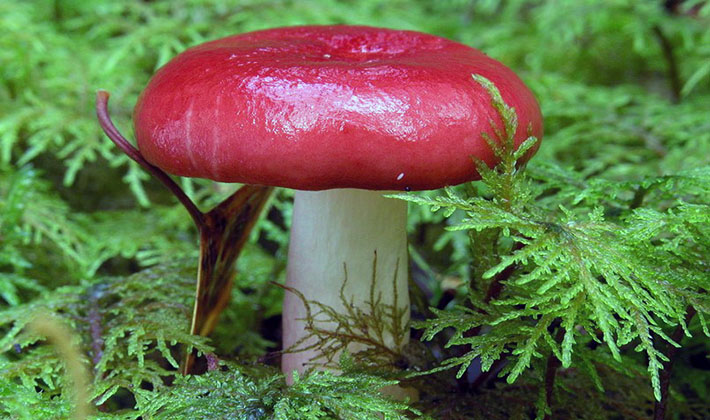
Russula mushrooms in July capture more and more forest areas. Especially a lot of them grows on forest, spruce litter, although some species prefer damp places.
Russula birch (Russula betularm).
Habitats: in damp deciduous or mixed forests, near birches.
Season: June - October.
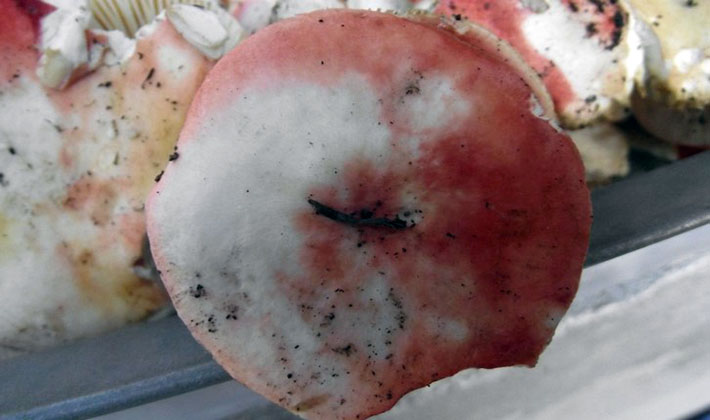
The hat has a diameter of 3-8 cm, it can be up to 10 cm. The shape is first convex hemispherical, later flat-depressed.A distinctive feature of the species is a depressed hat with a reddish-pink middle and light pink edges. The skin is smooth, shiny, sometimes covered with small cracks.
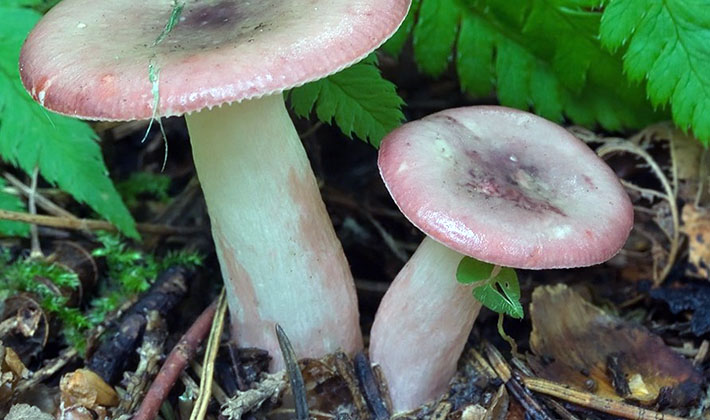
Leg: 4-10 cm long, 7-15 mm thick. The shape of the legs is cylindrical or slightly white, brittle. In old mushrooms, the leg becomes grayish.
The plates are frequent, wide, with slightly jagged edges. The color of the plates is first white, then white-cream.
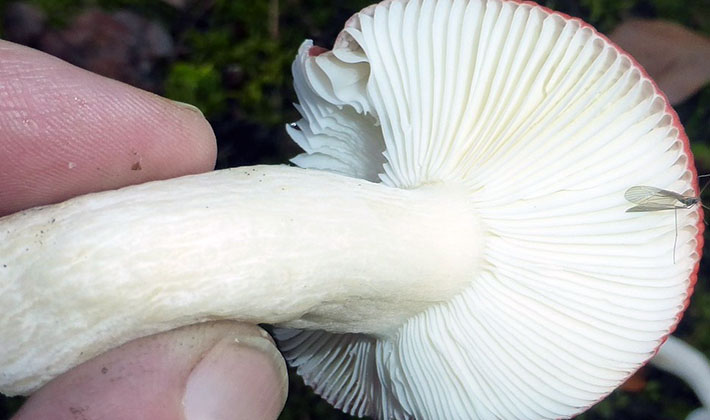
The pulp is white, brittle, tastes sweetish.
The spores are light buffy. Spore powder is pale yellow.
Variability. In young mushrooms, the edges of the cap are smooth and become scarred with age. The edges of the caps in young mushrooms can be completely white or with a slight pink tint, later pink. The middle is first pink, later red-pink.
Similarity to other species. The birch Russula is similar to the edible Swamp Russula (Russula paludosa), in which, on the contrary, the middle is lighter, yellowish, and the edges are darker, reddish. The birch russula can be confused with a burning vomiting (Russula emitica), which have a white leg and a sharp pepper taste, a burning red hat and there is no other color in the center.
Cooking Methods: pickling, boiling, salting, frying.
Edible, 3rd category.
Russula fading (Russula decolorans).
Habitats: coniferous, usually pine forests, in moss and blueberries, grow in groups or individually.
Season: July - September.

The cap is 4-10 cm in diameter, sometimes up to 15 cm, first spherical, hemispherical, later flat-convex, outstretched, until depressed with blunt smooth or ribbed edges. Color: tan, reddish orange, brick orange, yellowish orange. The hat fades unevenly over time, forming spots with a reddish and dirty gray color. The peel of young mushrooms is sticky, then dry and smooth.
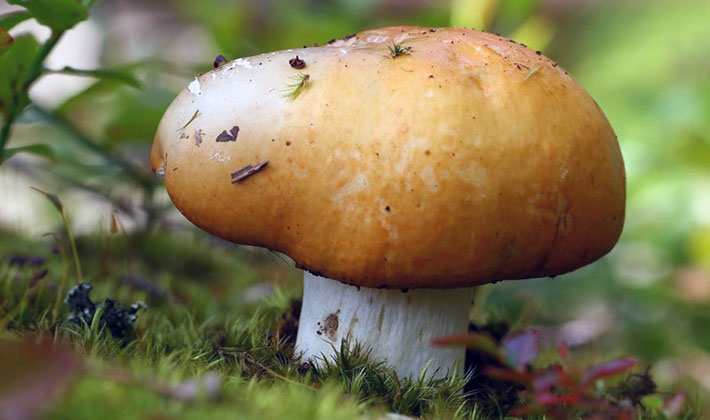
Leg 5-10 cm tall, 1-2 cm thick, cylindrical, sometimes narrowed to the base, dense, whitish, then gray or yellowish.
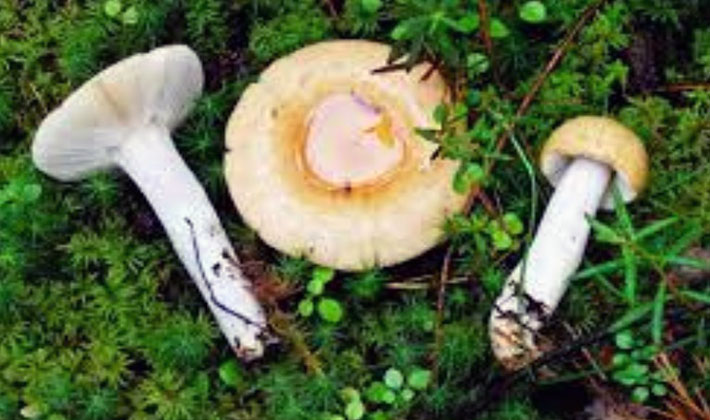
The pulp is white, fragile with a sweet taste, slightly sharp, turns gray on the fault.
Medium-frequency records, thin, wide, adherent, white with a yellow or gray tint, and even later - dirty gray.
Variability. The colors of hats and shades of fading are variable: brownish, reddish, rusty-brown and even greenish.
Similarity to other species. The fading Russula is a bit like the Russula emitica, in which the plates are white, the flesh does not turn gray and has a pungent taste, the color of the hat is reddish brown.
Cooking Methods: fried, pickled,
Edible, 3rd category.
Russula gall (Russula fellea).
Habitats: in spruce and deciduous forests, grows either in groups or singly.
Season: July - September.
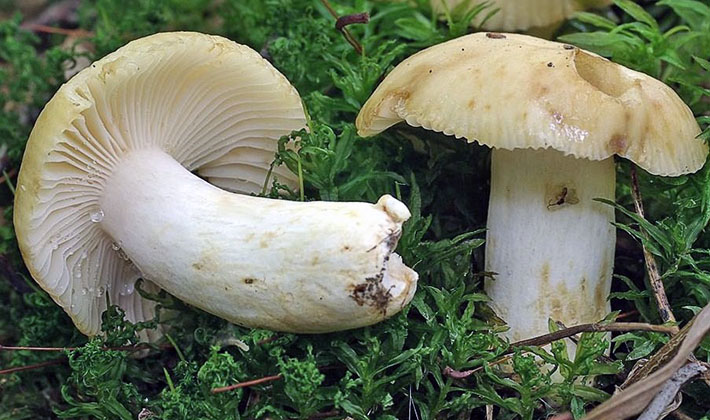
The cap is 4–9 cm in diameter, first hemispherical, convex, later convex-prostrate or flat, slightly depressed in the middle, smooth, dry, with blunt, smooth edges. A distinctive feature of the species is a straw yellow color with a yellow or slightly brownish middle and reddish-yellow edges.
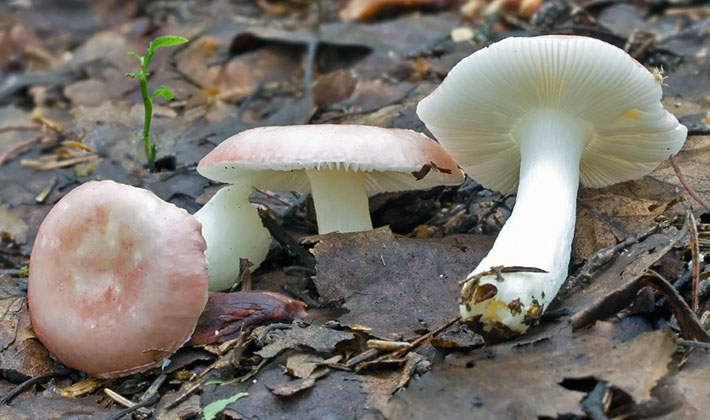
Leg 4-7 cm tall, 8-15 mm thick, cylindrical, smooth, dense, white. The color of the legs with age becomes the same straw yellow as the hat.
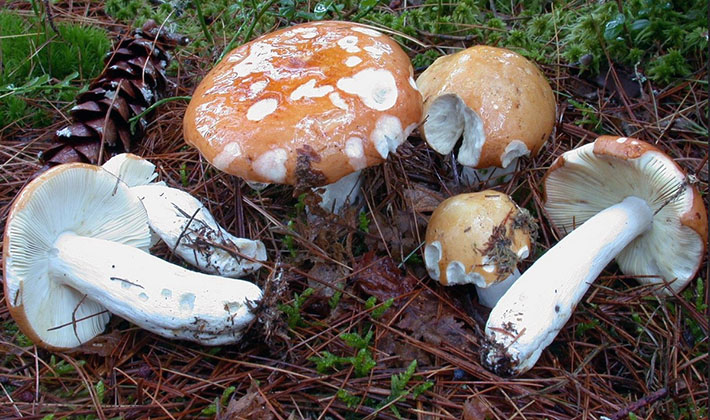
Pulp. The second distinctive feature of the species is the honey smell of pulp and a burning, pungent and bitter taste.
The plates are whitish, later almost the same color with a hat. Many records are branched. The spores are white.
Variability. The straw yellow color fades over time and the color of the hat becomes light yellow in the middle and slightly brighter at the edges.
Similarity to other species. Gall and conditionally edible russula can be confused with a good, tasty yellow russula (Russula claroflava), which has a bright yellow or lemon yellow color of the hat, but there is no smell of pulp.
They have a bitter taste, but when boiled in 2-3 waters the bitterness decreases, you can cook hot sauces.
Conditionally edible due to the sharp and bitter taste.
Russula green (Russula aeruginea).
Habitats: in coniferous and deciduous forests, mainly under birch trees.
Season: June - October.
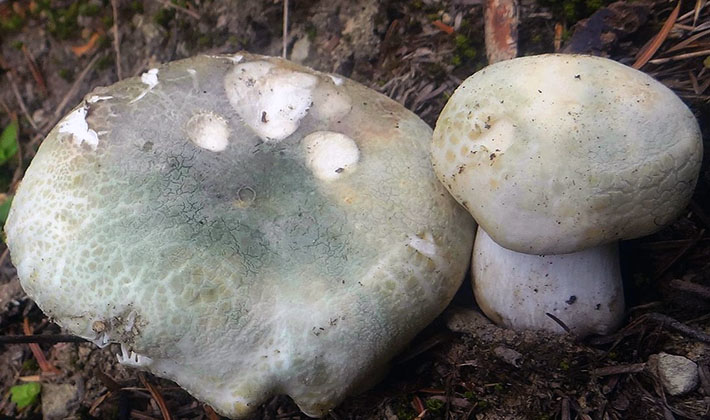
The cap is 5–9 cm in diameter, sometimes up to 15 cm, first hemispherical, convex, later convex-prostrate or flat, depressed with smooth or slightly ribbed edges. At the edges, the color may be lighter. A distinctive feature of the species is the greenish color of the hat with a darker color in the center. In addition, there are rusty or red-yellow spots in the center of the hat. The skin is sticky in wet weather, covered with thin radial grooves.
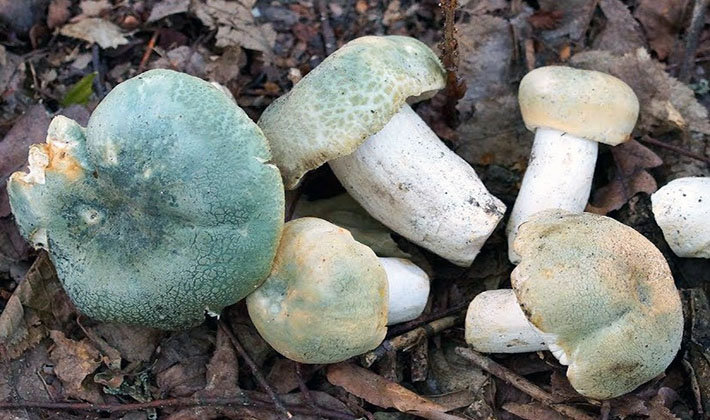
Leg 4–9 cm high, 8–20 mm thick, cylindrical, even, dense, smooth, shiny, white or with rusty brown specks. At the base, the leg may taper slightly. Leg gray on the cut.
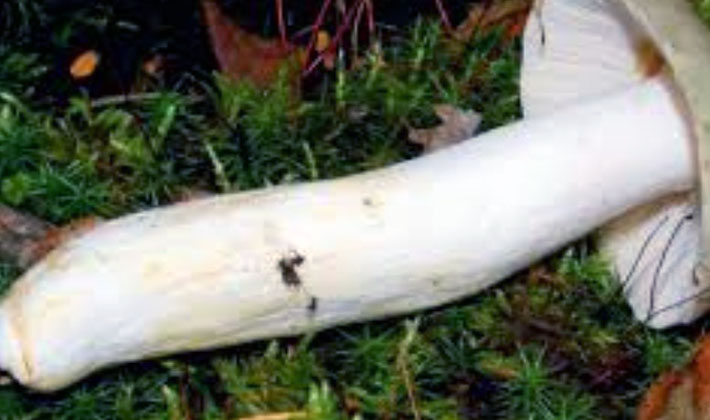
The pulp is dense, fragile, odorless and with peppery or burning taste.
The plates are frequent, bifurcated, loose or adherent, slightly descending along the stem, white or cream.
Variability. Over time, only the hue changes against the background of the general green color.
Similarity to other edible species. Russula green can be confused with Russula greenish (Russula virescens), in which the hat is not pure green, but yellow-green, and the leg is white with brownish scales at the base. Both species are edible.
Unlike the poisonous green form of the pale toadstool (Amanita phallioides): the green Russula has an even base of the leg, and the pale toadstool has a ring on the leg and a swollen vagina at the base.
Methods of preparation: pickling, frying, salting.
Edible, 3rd category.
Russula luteotact, or whitish (Russula luteotacta).
Habitats: mixed forests.
Season: July - September.
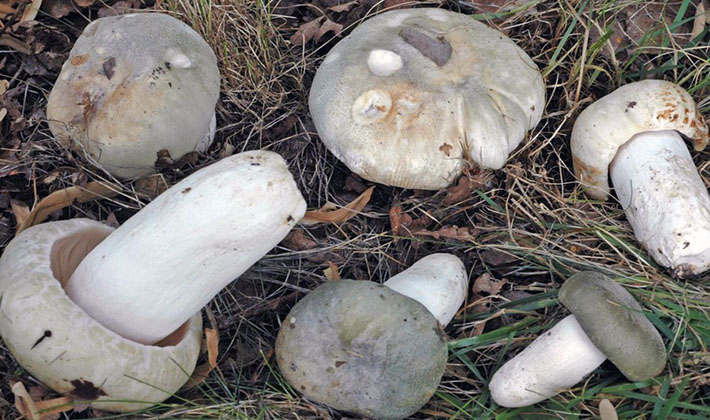
The cap is 4-8 cm in diameter, sometimes up to 10 cm, first hemispherical, later convex and prostrate, depressed in the middle. A distinctive feature of the species is a whitish hat with a center having a tan shade. The edges of the caps in mature specimens are uneven, furrowed.
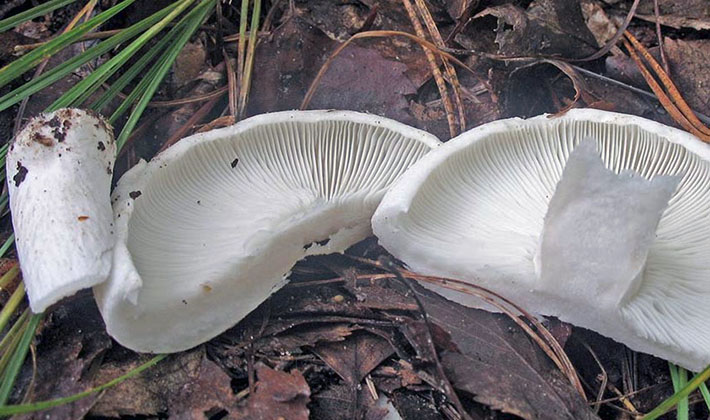
Leg 4–9 cm high and 7–20 mm thick, white, cylindrical, slightly expanding downward, first dense, later hollow.
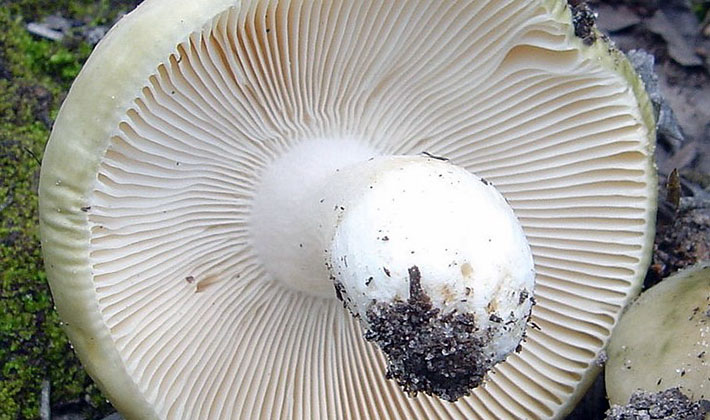
The pulp is white, brittle with a faint, slightly bitter taste.
The plates are frequent, white or creamy white. The spores are white.
Variability. The color of the hat varies from pure white to yellowish with a center, in which yellow and brown tones predominate.
Similarity to other species. This russula can be confused with the conditionally edible russula russula (Russala farinipes), which has an ocher-yellow hat.
The difference from the poisonous white form of the pale toadstool (Amanita phallioides) is that the pale toadstool has a ring on the leg and a bloated Volvo at the base.
Conventionally edible due to the bitter taste.
Russula buffy-yellow (Russula ochroleuca).
Habitats: coniferous and deciduous forests, grow in groups and individually.
Season: July - September.
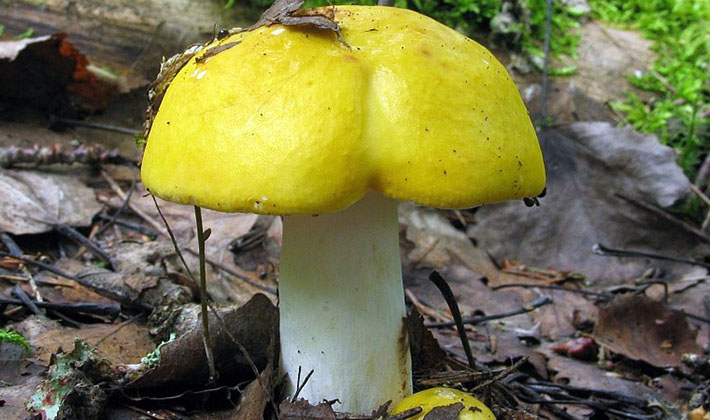
The cap is 4-10 cm in diameter, first hemispherical, later convex and prostrate, depressed in the middle. The surface is dull, dry, in wet weather it becomes sticky. A distinctive feature of the species is the ocher-yellow color, sometimes with a greenish tint. The center of the cap may have a darker shade, brownish silt and reddish yellowish. The peel is easily removable.
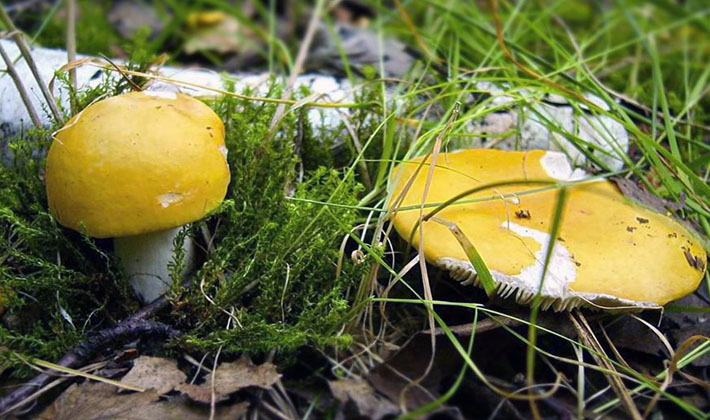
Leg 4–9 cm high and 1-2 cm thick, smooth, cylindrical, first white, later grayish yellow.
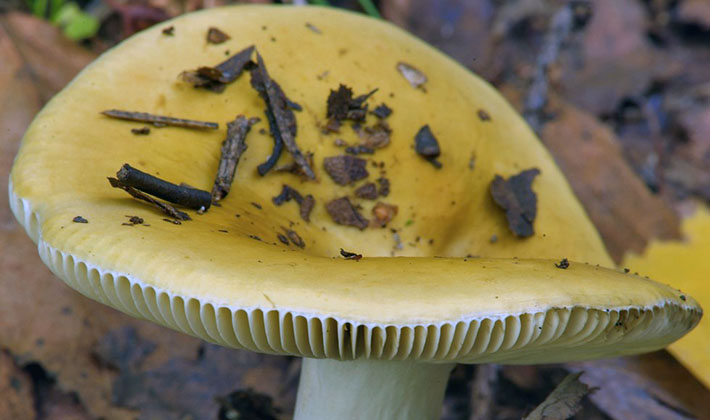
The pulp is fragile, whitish, with a sharp taste.
The plates are thick, adherent, white or light cream.
Variability. The white cylindrical leg turns gray with age.
Similarity to other edible species. Russula ocher yellow can be confused with an edible yellow Russula (Russula claroflava), which has a bright yellow hat and white flesh, which slowly turns black on the cut.
The difference from the poisonous pale toadstool (Amanita phallioides) with a variant with an olive or yellowish color of the hat is that the pale toadstool has a ring on the leg and a bloated Volvo at the base.
Conditionally edible due to pepper taste. Suitable for cooking hot seasonings. The severity decreases when boiling in 2-3 waters.
Russula purplish-reddish (Russula obscura).
Habitats: boggy coniferous and deciduous forests grow in groups or singly.
Season: July - September.
Therapeutic properties:
- Russula purplish-reddish has antibiotic properties against pathogens of various diseases - staphylococci and against harmful bacteria - pullularia. Tinctures based on these fungi have antibacterial properties and are able to suppress the reproduction of staphylococci.
- Coloring purple-red are active against harmful bacteria. This allows you to have a stronger antibacterial effect.
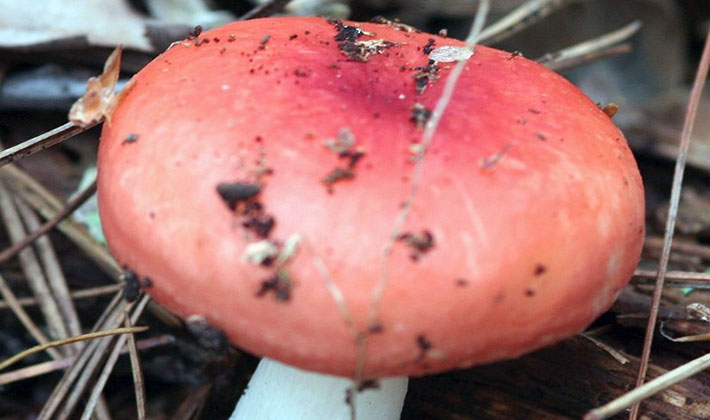
The cap is 4-15 cm in diameter, first hemispherical, later prostrate, depressed in the middle, with a wavy, sometimes serrated edge. The surface in wet weather is slightly sticky, in other weather - dry. A distinctive feature of the species is the main purplish-reddish color and variations are possible: reddish-bluish, brownish-red with a gray tint. In young mushrooms, the central part of the hat is darker, but later it fades to a yellowish-brown hue.
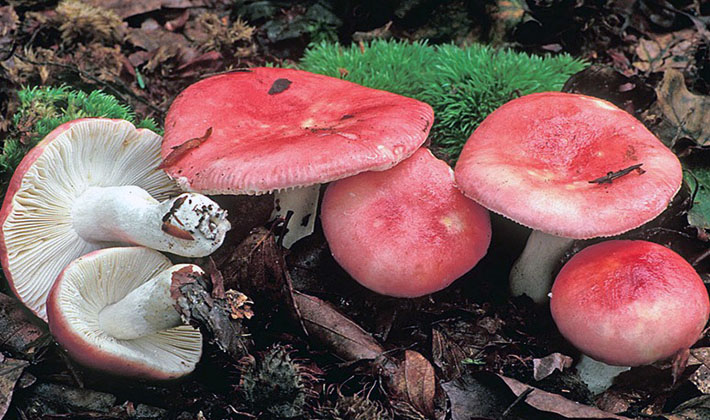
Leg 4-10 cm tall and 1-2.5 cm thick, cylindrical, dense, slightly narrowed to the base, becomes loose over time.
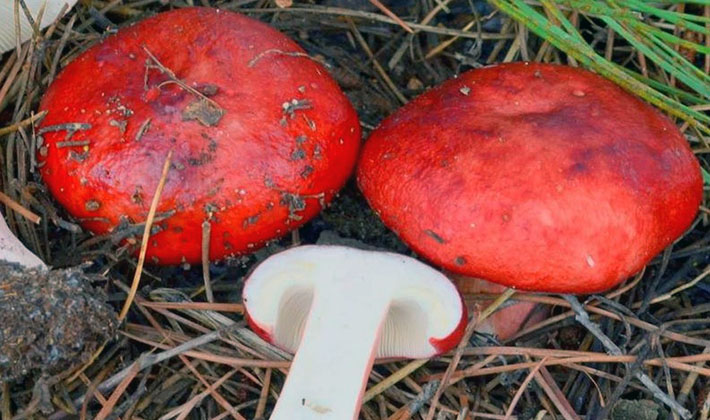
The flesh is white, turning gray at the fault, with a pleasant, soft, pungent taste.
Plates 0.7-1.2 cm wide, in young specimens white, later with a yellowish tint, Creamy spore powder.
Variability. The color of the hat is variable: from purplish-reddish to brownish-red and to brick-brown.
Similarity to other species. Russula purplish-reddish can be confused with an inedible hot-caustic Russula (Russula emitica), in which the hat is red, pink-red or purple, the legs are pinkish in places, the flesh is white, under the skin pinkish, with a very burning taste.
Ways to use: pickling, salting, frying.
Russula pink (Russula rosea).
Habitats: deciduous and pine forests, in groups or singly.
Season: August - October.
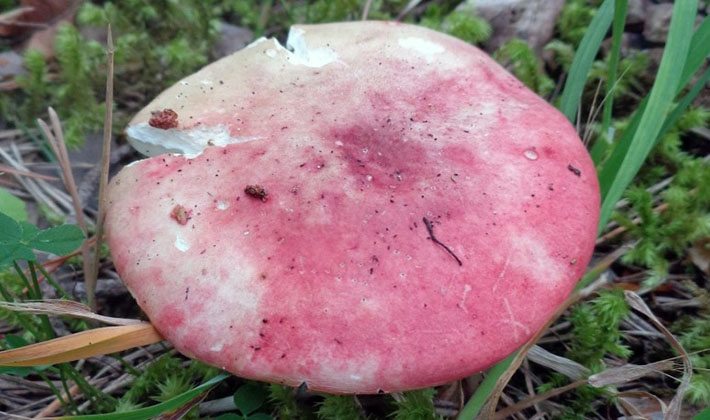
Hat with a diameter of 4-10 cm, first hemispherical, later prostrate, concave in the middle, dry with an even thick edge. The surface in wet weather is slightly sticky, in other weather - dry. A distinctive feature of the species is pink, pink-red, pale red color with blurry whitish and yellowish spots. The peel is not removable.
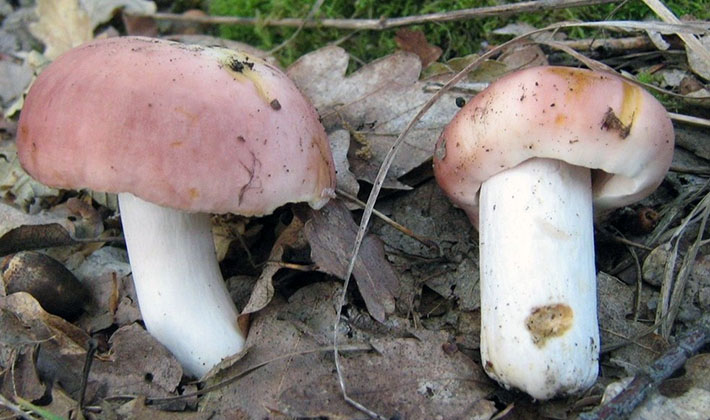
Leg 4-8 cm tall, 1-2.5 cm thick, short, first white, then pinkish, fibrous, cylindrical.

The pulp is dense, brittle, whitish in color, bitterish in young mushrooms, and sweet in mature ones.
The plates are thin, medium frequency, narrow, first white, later cream or pinkish-cream. The plates are either narrowly grown or loose.
Variability. The color of the hat is variable: from pink-red to yellow-pink.
Similarity to other species. The pink Russula is similar to the edible swamp Russula (Russula paludosa), in which the hat is orange-red, the leg is slightly club-shaped, white in color with a pink tint. The pulp of bog russula does not have a bitter taste, but a pleasant mushroom.
Conditionally edible mushroom due to its bitter taste, is used for cooking hot seasonings. The bitter taste can be mitigated by
Russula violet, or lilac (Russula violaceae).
Habitats: pine, spruce and mixed forests, grow in groups or singly.
Season: July - October.
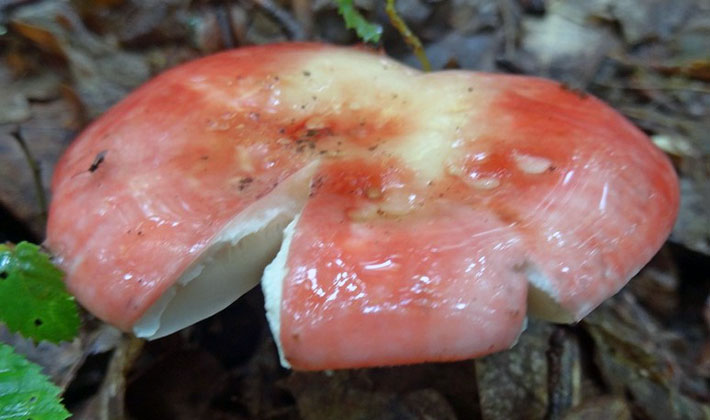
A hat with a diameter of 4-10 cm, sometimes up to 12 cm, is first convex, hemispherical, then prostrate, almost flat with a concave middle. A distinctive feature of the species is a purple hat with uneven wavy edges and a darker shade in the middle. In addition, the edges of the cap hang down.

The leg has a length of 5-10 cm, a thickness of 7-15 mm, it is white in color, cylindrical in shape.

The pulp is brittle, white.
The plates are frequent, grown, first white, and creamy as they mature.
Variability. The color of the hat varies from violet to lilac and brown-violet.
Similarity to other edible species. Russula violet can be confused with the violet form of a fragile Russula (Russula fragilis, f.violascens), which is distinguished by the presence of chips and a brittle hat, as well as light purple.
Cooking Methods: pickling, salting, frying. Mushrooms are listed in the regional Red Books, status - 3R.
Edible, 4th category.
Valui
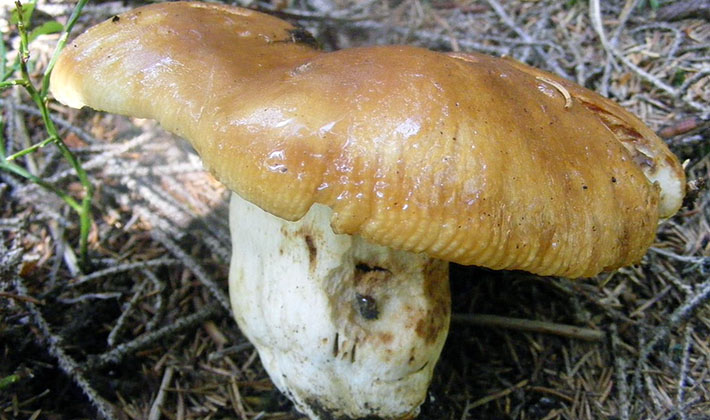
Valui in July is growing everywhere, preferring high places. In villages and places with a long tradition, valui are collected a lot, soaked and salted in barrels. In the vicinity of big cities there are also a lot of them. But here they are almost not collected, preferring other species. They differ in a variety of shapes and sizes: from spherical on the leg to umbrella-shaped.
Valui (Russula foetens).
Habitats: mixed with birch and coniferous forests, grow in groups.
Season: July - September.
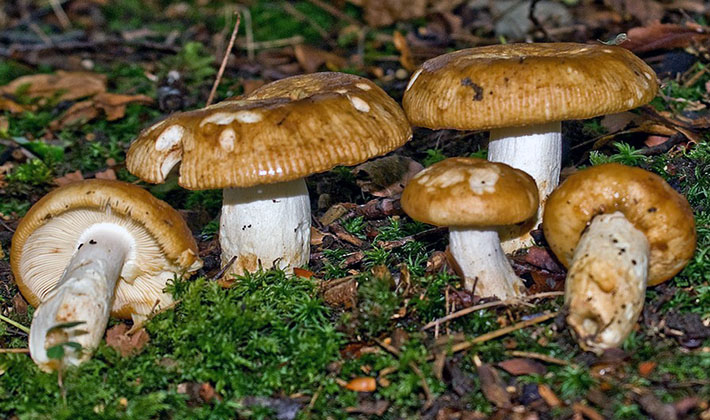
The cap is 3-15 cm in diameter, sometimes up to 18 cm, fleshy, at first spherical and hemispherical, then flatly spread, often with a small indentation in the middle, mucous, sticky, with a ribbed edge, sometimes cracking. A distinctive feature of the species is the spherical shape of young specimens and the color of the hat: ocher, straw, dirty yellow, orange-brown. The peel is not removable.
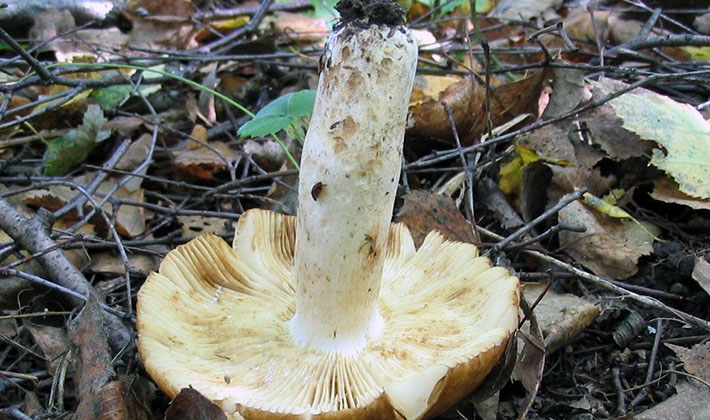
Leg 3-8 cm tall, 1-2.5 cm thick, cylindrical, sometimes in the middle swollen, first spongy, of the same color with a hat. The second distinctive feature of the species is a hollow leg with several empty cavities.
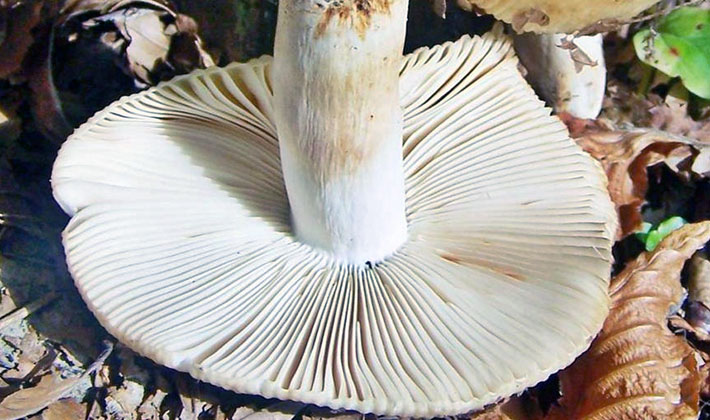
The pulp is white, then ocher, in a hat is dense, in the leg is spongy, friable with an unpleasant odor and taste. The unpleasant odor intensifies in old mushrooms.
The plates are adherent, yellowish or cream-brown with brownish spots, fork-branched, frequent, usually dropping droplets of fluid along the edge. Spore powder is white or cream.
Variability. The color of the hat can vary greatly: from orange-brown to light yellow, and the plates from light yellow and cream to brown.
Similarity to other species. Valui is a bit like a conditionally edible ocher-yellow russula (Russula ochroleuca), in which the color of the hat is ocher-yellow with a greenish tint, the leg is smooth cylindrical, whitish. The shape of the hat is especially different: for young and mature valuables it is spherical or hemispherical and only later becomes flat, like in russula.
Cooking Methods: salting after pretreatment.
Edible, 4th category.
Miller and rubella

Millers and rubella are all edible mushrooms. Among them there are especially aromatic and tasty, for example, wood lactacles, characterized by an unusual contrast in the colors of the caps and plates. However, all of them require preliminary soaking before final salting.
Woody or brown milky (Lactarius lignyotus).
Habitats: coniferous forests, among moss, usually grow in groups.
Season: Aug. Sept.
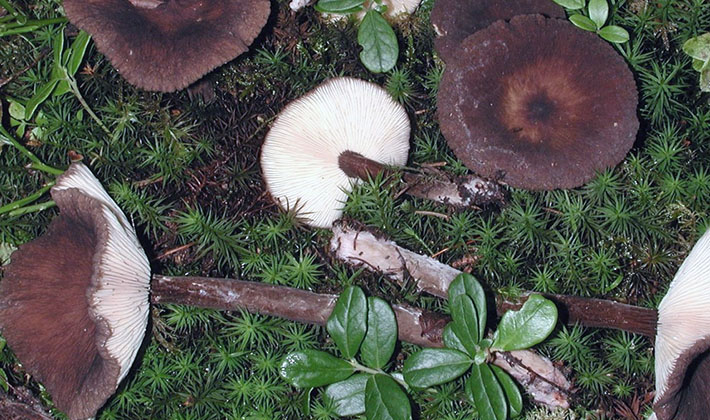
The hat has a diameter of 3-6 cm, dense, smooth, first convex, later flat-conical. A distinctive feature of the species is an unusual combination of colors: dark, chestnut, brown, dark brown or black and brown hat, often with a noticeable tubercle in the middle, bright and light plates and a dark blackish leg.
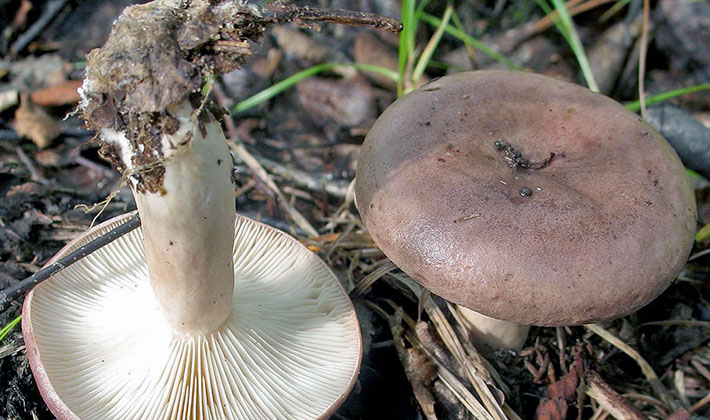
Leg 4–12 cm long, 0.6–1.5 cm thick, cylindrical, often winding; the color of the hat is dark brown, blackish, brown, chestnut.

The flesh is white, later slightly yellowish, reddish in the section.
The plates are frequent, slightly descending along the pedicle or adherent, light cream or yellowish-cream.
Variability. The color of the hat and legs can vary from dark brown to brown and black-brown.
Similarity to other species. The fungus is so characteristic and contrasting in the dark color of the hat, legs and light plates that it easily differs from others and does not have closely similar species.
Cooking Methods: cooking, salting, frying.
Edible, 2nd category.
Rubella (Lactarius subdulcis).
Habitats: deciduous and mixed forests grow in groups.
Season: July - October.
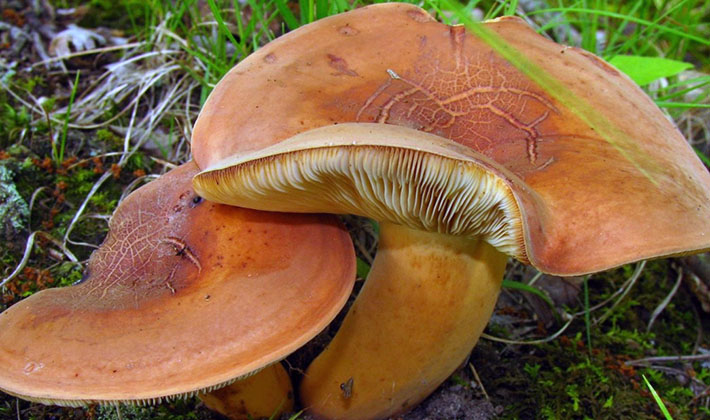
The hat has a diameter of 4–9 cm, it is dense, but the crowbar is shiny, first convex, later flat-spread, slightly depressed in the middle.The surface is matte, smooth or slightly wrinkled. A distinctive feature of the species is rusty-reddish, red-brown, yellowish-brown color.
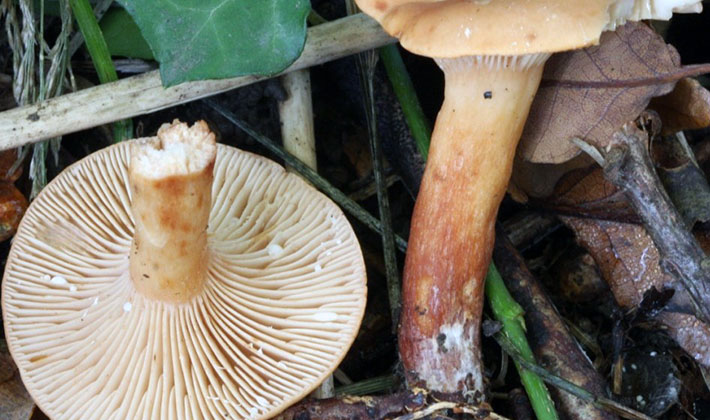
Leg 3-7 cm tall, 0.6-1.5 cm thick, cylindrical, slightly narrowed at the base, sometimes with longitudinal hairy stripes, smooth, brownish.
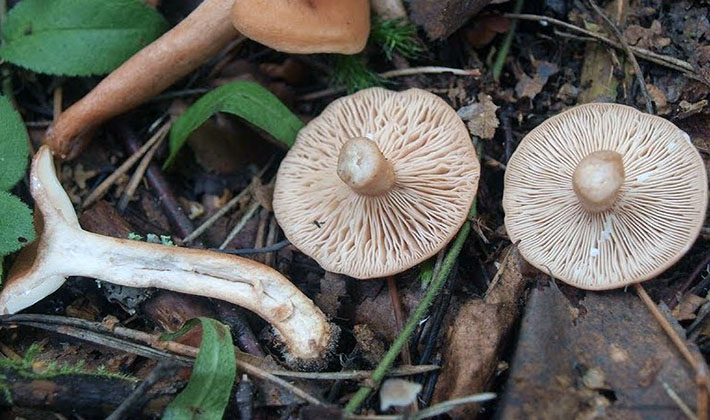
The pulp is fragile, brownish-yellowish, with a slight unpleasant odor and bitter taste.
The plates are frequent, narrow, slightly descending along the leg, light brown. With an incision, white liquid milky juice is secreted, at first sweetish, but after a short time it starts to bitter.
Variability. The color of the hat and legs can vary from rusty red to dark brown.
Similarity to other species. Rubella is similar to bitter (Lactarius rufus), in which the flesh is whitish rather than brownish-yellowish and has a central tubercle.
Cooking Methods: conditionally edible mushroom, since it requires preliminary obligatory boiling, after which it can be salted.
Edible, 4th category.
In the final section of the article, you will find out what inedible mushrooms grow in July.
Inedible mushrooms in July
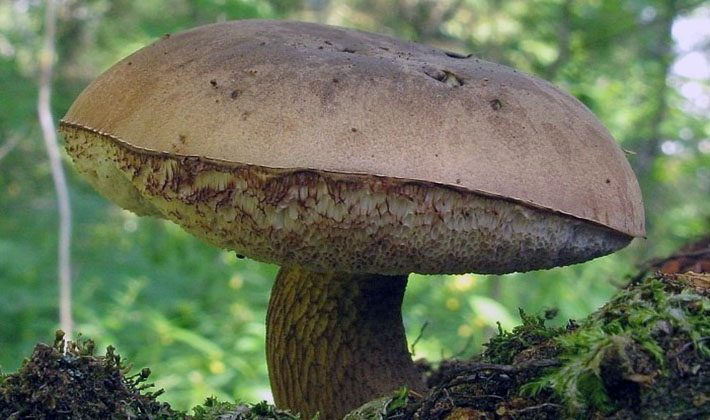
Bile fungus (Tylopilus felleus).
In a dense and dark forest, exclamations are often heard: “Found the boletus! Also, there are several of them! ”A closer look reveals that these mushrooms have pinkish plates. From afar, they really look like porcini mushrooms or brown boletus. Some even cook them. They are non-toxic, but very bitter. These are bile mushrooms.
The healing properties of bile fungi:
- Bile fungus has a choleretic effect. From it, preparations are prepared for the treatment of the liver.
Habitats: damp places in coniferous and mixed forests, near rotten stumps, are found singly and in groups.
Season: July - October.
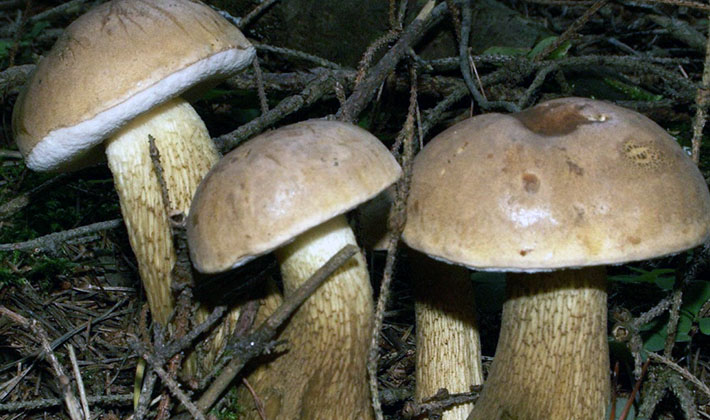
The hat has a diameter of 4 to 15 cm, thick-fleshy, first hemispherical, later rounded-pillow-shaped and then prostrate or flat-convex. The surface is slightly velvety, later smooth, dry. Color: light chestnut, brownish with gray, yellowish or reddish hues.
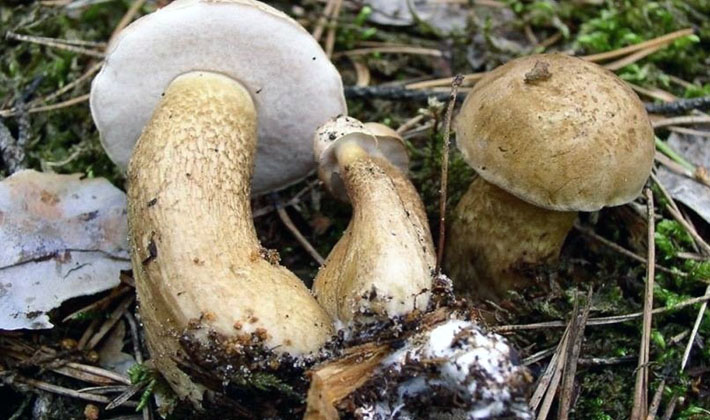
Leg 4-13 cm tall and 1.5-3 cm thick, first cylindrical, later with a club-shaped at the base. The color of the legs is creamy ocher or yellowish brown. Above the leg there is a clear dark black-brown mesh pattern.
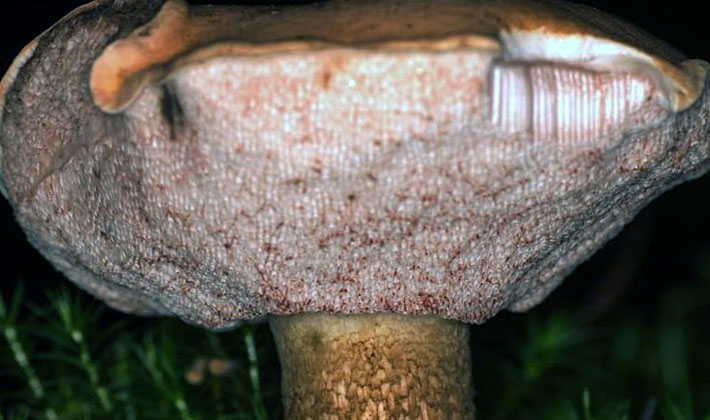
The pulp is dense, thick, pure white, in old mushrooms it is friable, turning pinkish. A distinctive feature of the species is the burning-bile taste of the pulp, although the smell is pleasant, mushroom.
The tubular layer - grown at the legs, sometimes notched. The second distinguishing feature of the species is a pale pink or dirty pink color of the down and tubes. When pressed, the layer turns pink. In young mushrooms, the color is almost white. The pores are round or angular, small. Spore Powder - Dun, Rose Brown, Pink.
Variability. The color of the cap during the growth of the fungus varies from light brown to brownish-brown, and the tubular layer - from white to pink.
Similar views. At a young age, when the tubules are white, the bile fungus can be confused with different types of porcini mushrooms. However, the cep has a tasteless flesh and it has a white color, does not change color at the break and, most importantly, there is no very bitter taste.
Inedible, have a burning-bitter taste.
Float
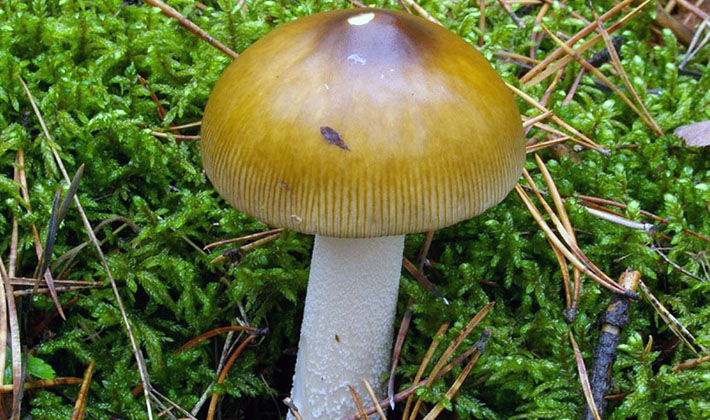
July floats stand out well in the grass. These cute, slender mushrooms with a long leg, although inedible, always attract mushroom pickers.
Snow-white float (Amanita nivalis).
Habitats: deciduous and mixed with birch forests grow either in groups or singly.
Season: August - October.
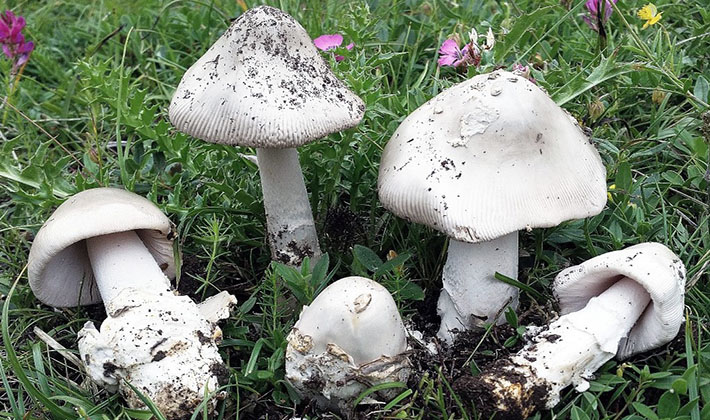
The hat is thin, has a diameter of 3-6 cm, first ovoid, later convex-prostrate and quite flat. A distinctive feature of the species is a snow-white, small-scaled hat with a blunt tubercle, with hatching at the edges and a long and thin whitish leg with a Volvo. The edges of the cap are straight at first, later wavy.
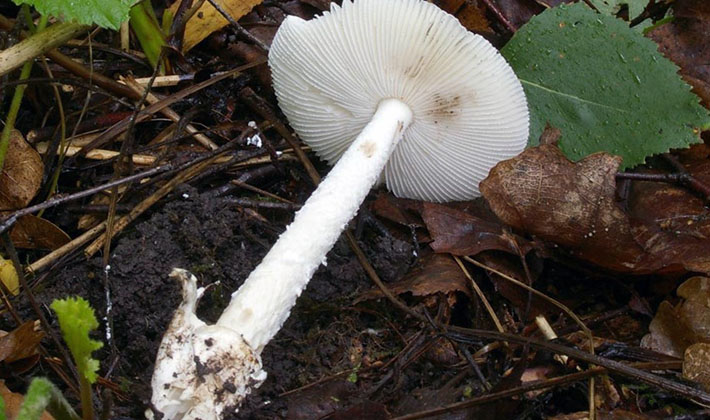
Leg 5–16 cm long, 5–10 mm thick, smooth, smooth, first white, then light cream with large scales.

Pulp: whitish, watery, brittle, odorless.
The discs are free, frequent, soft, white.
Variability. The color of the hat varies from white to whitish with a tubercle.
Similar views. The inedible snow-white float is similar to young specimens of the poisonous fly agaric Amanita (Amanita citrine), which is distinguished by a large white ring on the leg and a thick fleshy hat.
Inedible.
The ocher-gray float (Amanitopsis lividopallescens).
Habitats: deciduous and mixed forests grow either in groups or singly.
Season: August - October.
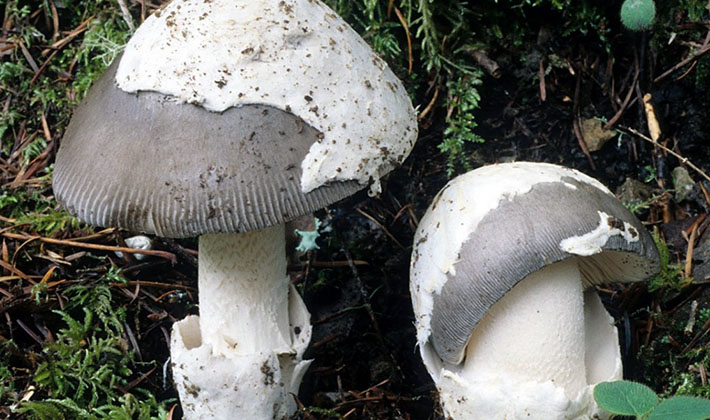
The hat is thin, has a diameter of 3-7 cm, first hemispherical, later convex-spread and quite flat. A distinctive feature of the species is the ocher-gray hat with a blunt tubercle, an uneven surface and cracking edges with time. In young specimens, the central region of the cap is lighter, almost white.
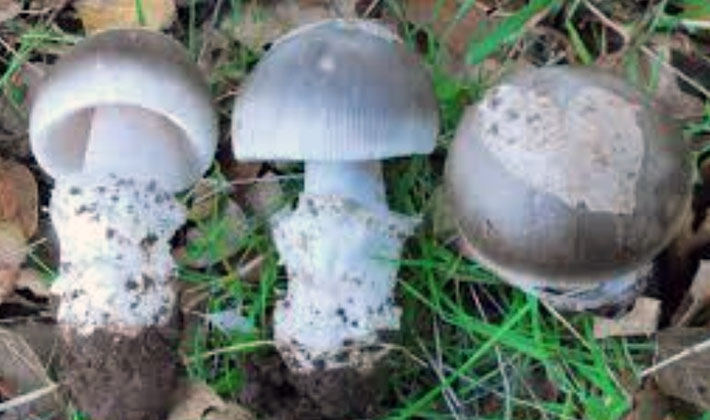
The leg is thin long 5-12 cm high, 6-15 mm thick.
The leg is whitish above, the bottom is the same color as the hat. The base of the leg is thickened.
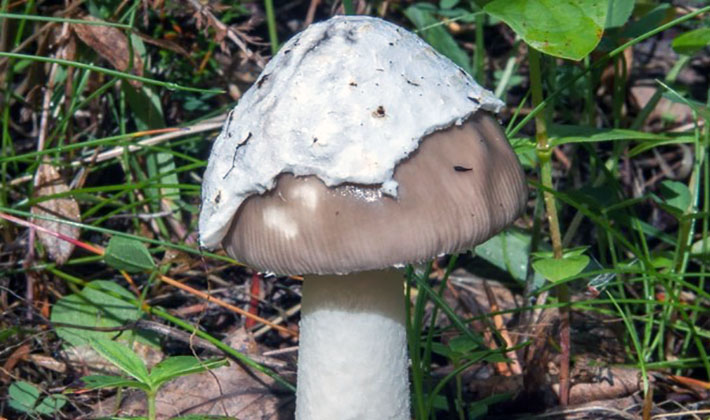
Pulp: whitish, odorless.
The plates are frequent, soft, white, notched-attached.
Variability. The color of the hat varies from ocher gray to whitish and yellowish.
Similar views. The inedible silver float is similar to the poisonous white form of a pale toadstool (Amanita phalloides), which is distinguished by the presence of a wide ring on the leg and the absence of hatching at the edges of the hat.
Inedible.
Pale toadstools.
- Pale grebes are deadly poisonous, for that they are grebes.
Pale toadstool, white form (Amanita phalloides).
Habitats: deciduous and mixed forests, on humus-rich soil, grow either in groups or singly.
Season: August - November.
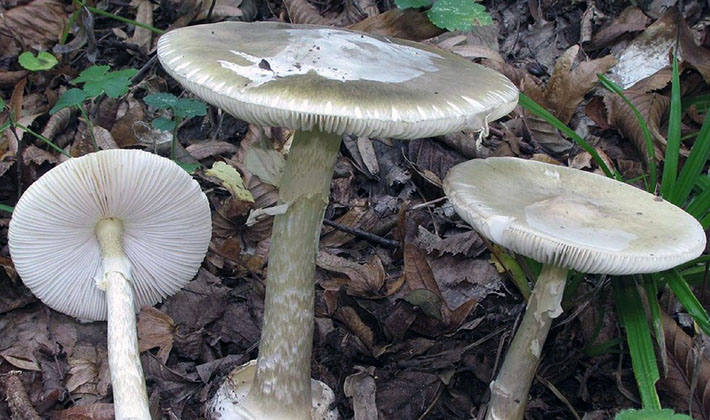
The hat has a diameter of 6-15 cm, first hemispherical, later convex-spread. A distinctive feature of the species is a smooth fibrous whitish surface of the hat without scales and a leg with a Volvo and a wide ring.
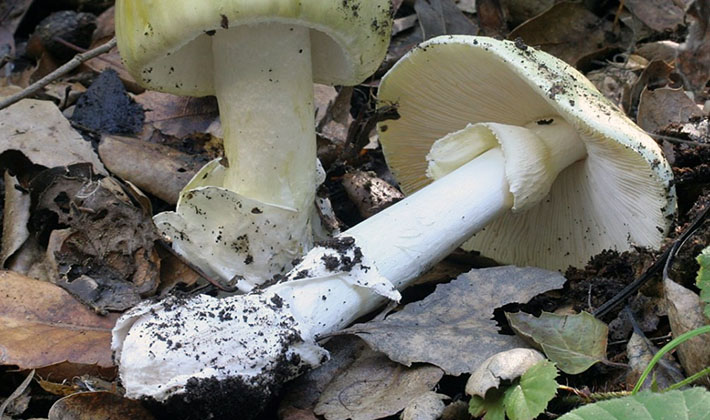
Leg 6-16 cm tall, 9-25 mm thick, white, smooth. In the upper part of the peduncle, young specimens have a white wide ring. The ring may fade over time. At the base, the leg has a tuberoid thickening covered with Volvo.
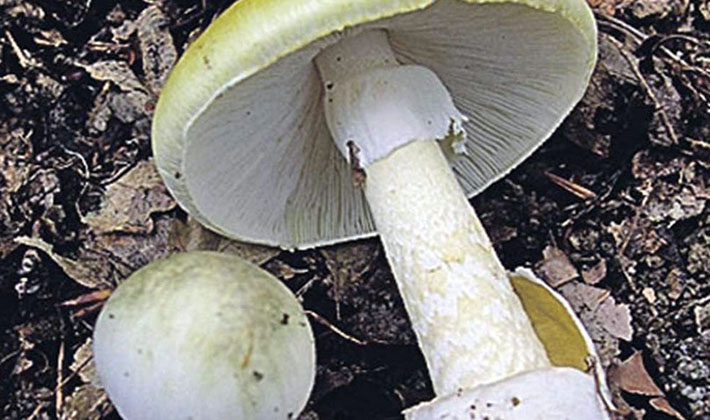
Pulp: white, yellowish under the skin, with a faint smell and taste.
The discs are free, frequent, soft, short, white.
Variability. The color of the hat does not change much - it is either pure white or whitish with spots of a pinkish tint.
Similar views. One must be especially careful when collecting good edible champignons - meadow (Agaricus campestris), large-spore (Agaricus macrosporus), field (Agaricus arvensis). All these champignons at an early age have light plates with a slight yellowish or slightly noticeable pinkish tint and light hats. At this age, they can be confused with a deadly poisonous toadstool. In adulthood, the plates of all these champignons are light brown, pink, brownish, while in the pale grebe they remain white.
Deadly poisonous!
Waxed Talker (Clitocybe cerussata).
Among the talkers, most of the inedible and even poisonous mushrooms. They can be distinguished by a cone-shaped leg and plates crawling on the leg. In July, one of the most poisonous is found - a waxy talker.
Habitats: mixed and coniferous forests, in grass, on sandy soils, grow individually or in groups.
Season: July - September.
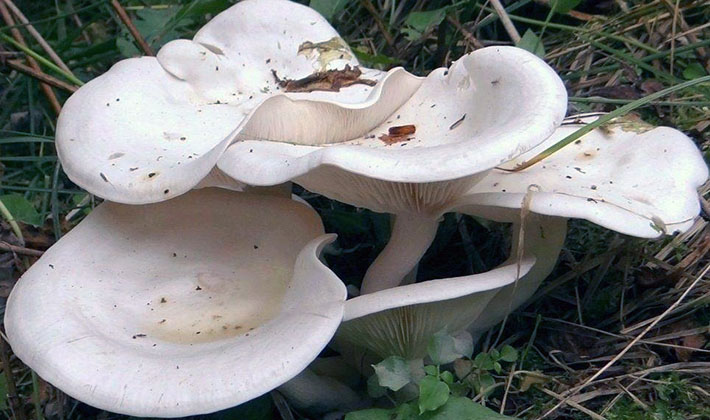
The hat is 3-7 cm in diameter, first convex, then prostrate and convex-depressed. A distinctive feature of the species is a waxy or whitish hat with whitish concentric zones and wavy edges.
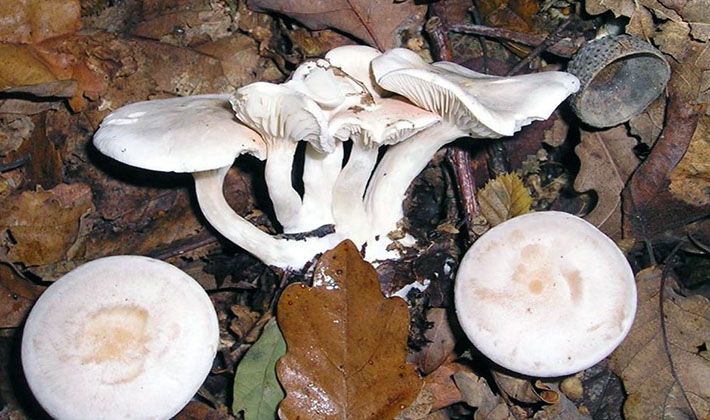
Leg 3-6 cm tall, 4-12 mm thick, creamy or whitish with thinning and pubescence at the base.

The pulp is white, brittle, with an unpleasant odor.
The plates are frequent, narrow, strongly descending along the leg, first whitish, later white-cream. Spore powder is white.
Variability: the color of the hat varies from white to ivory and white-cream.
Similar views. The waxy talker is similar to the poisonous whitish talker (Clitocybe dealbata), which is distinguished by a slightly funnel-shaped and strong mealy smell.
Poisonous.
